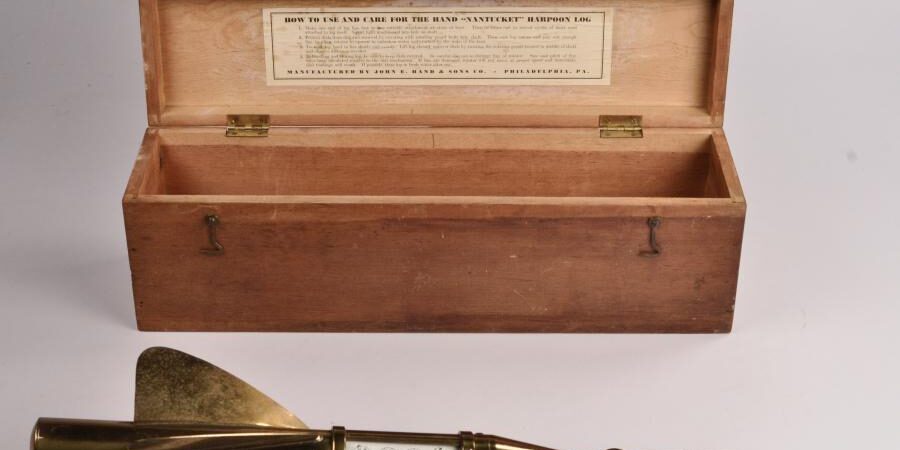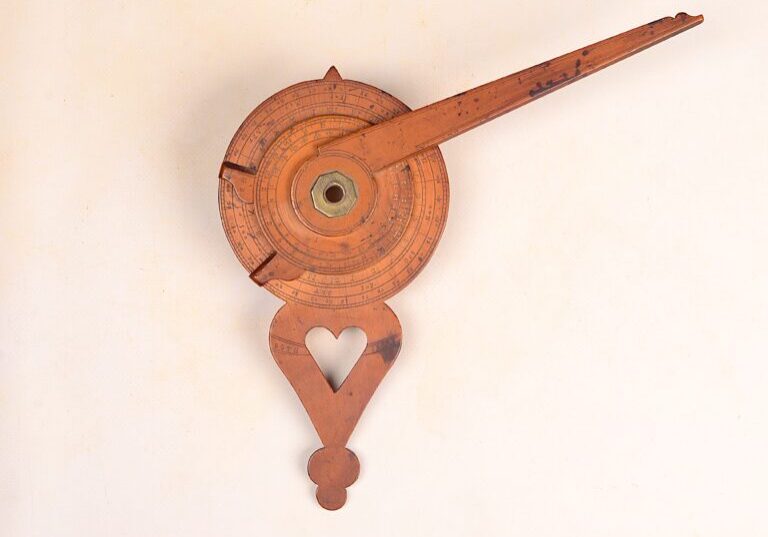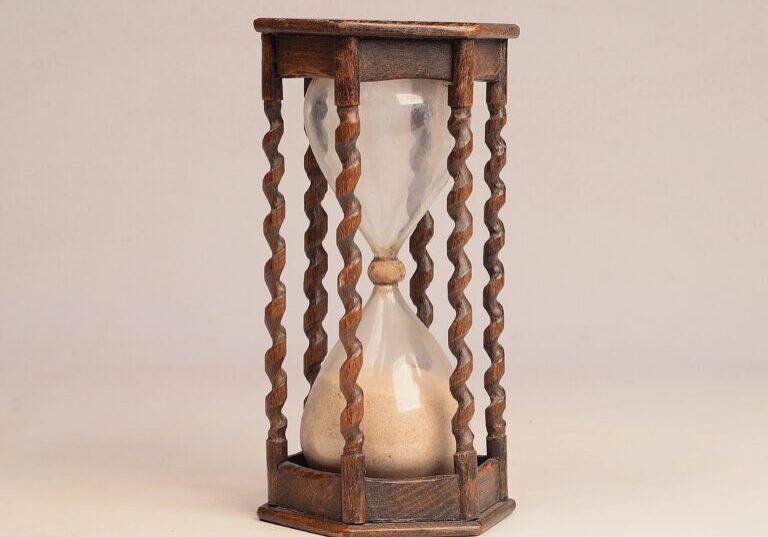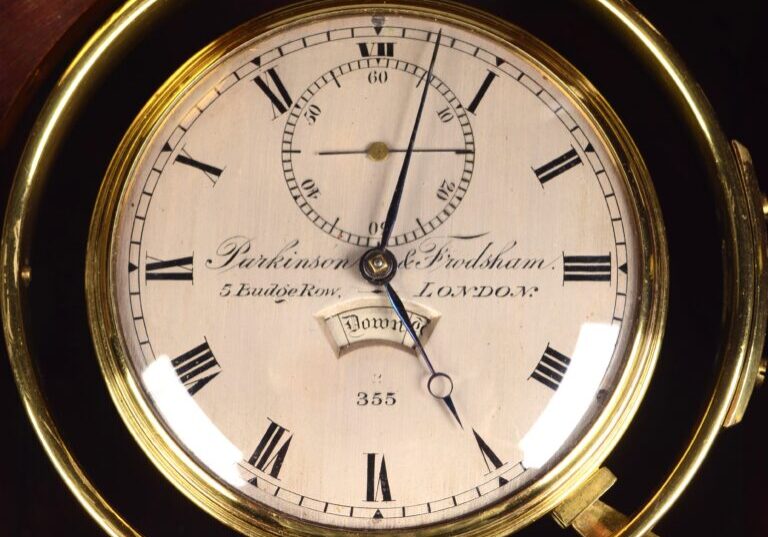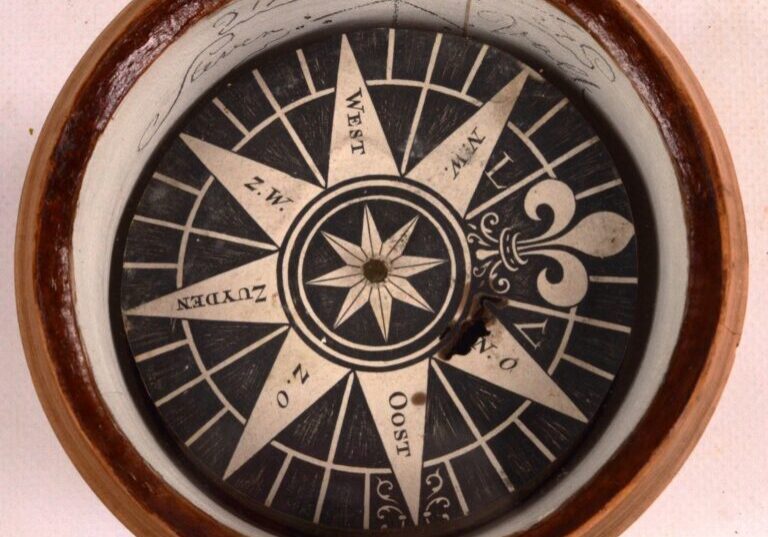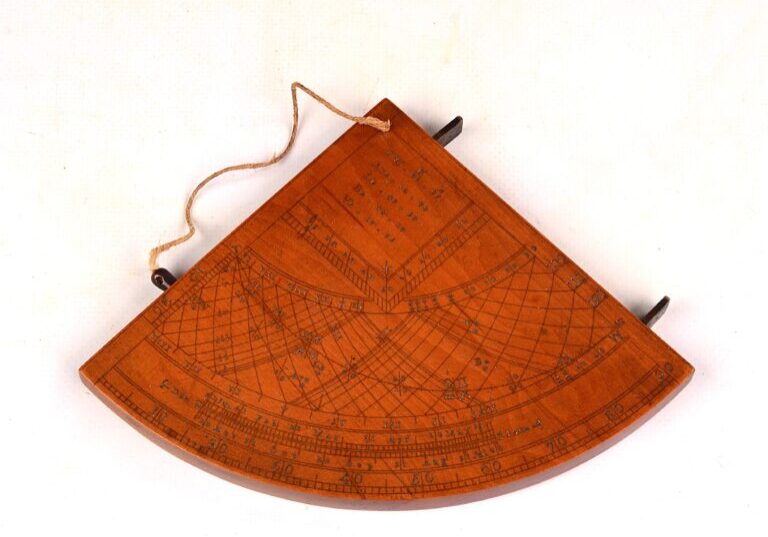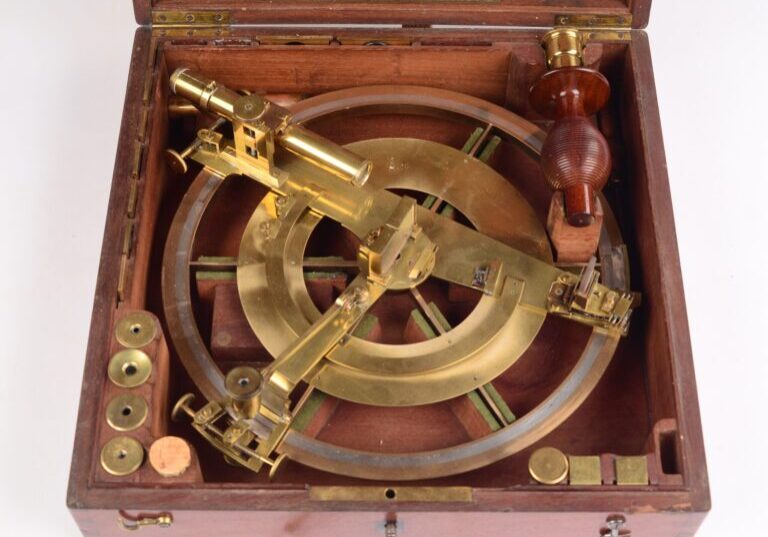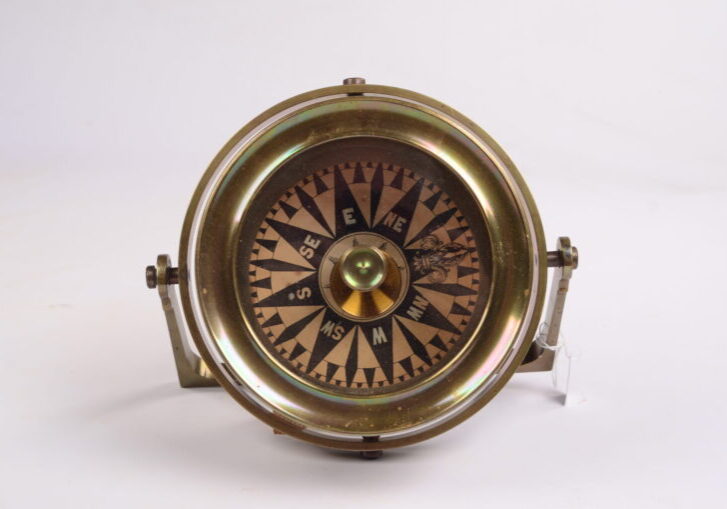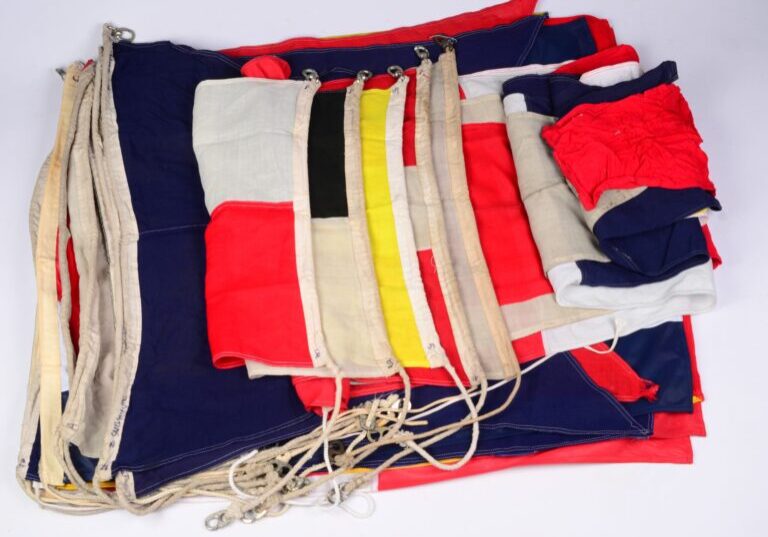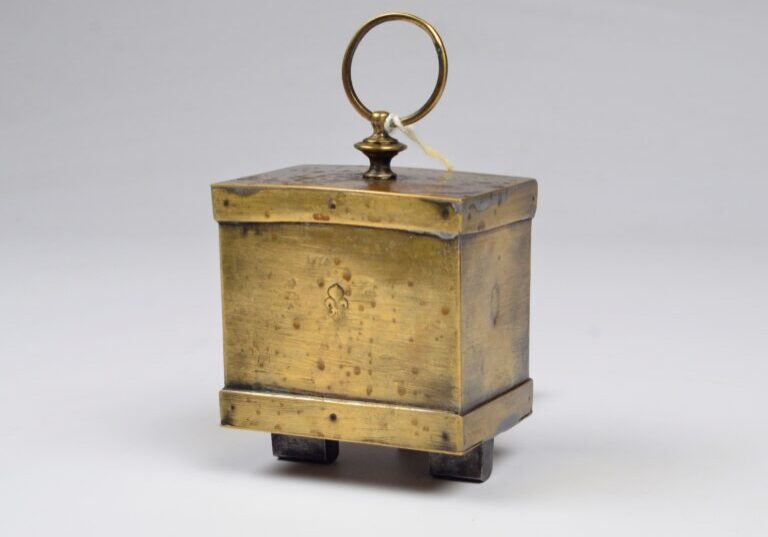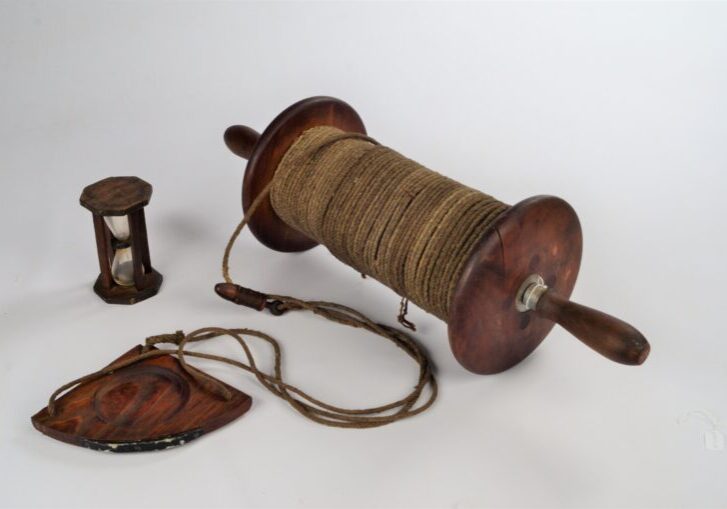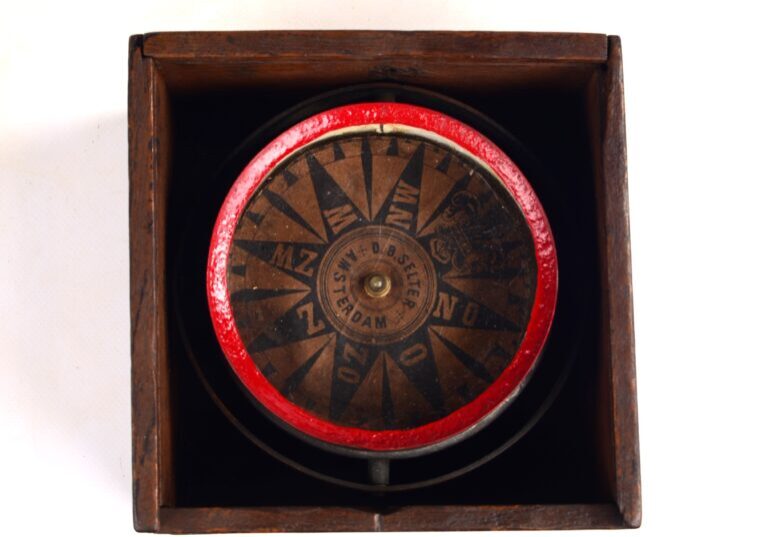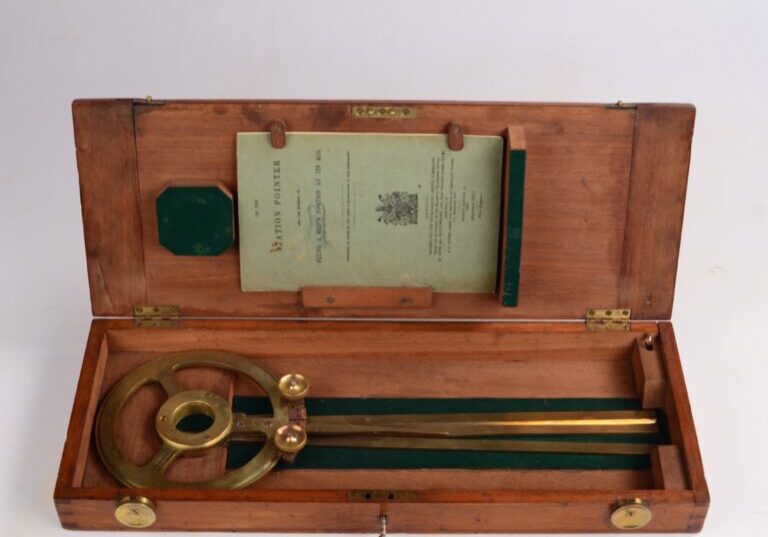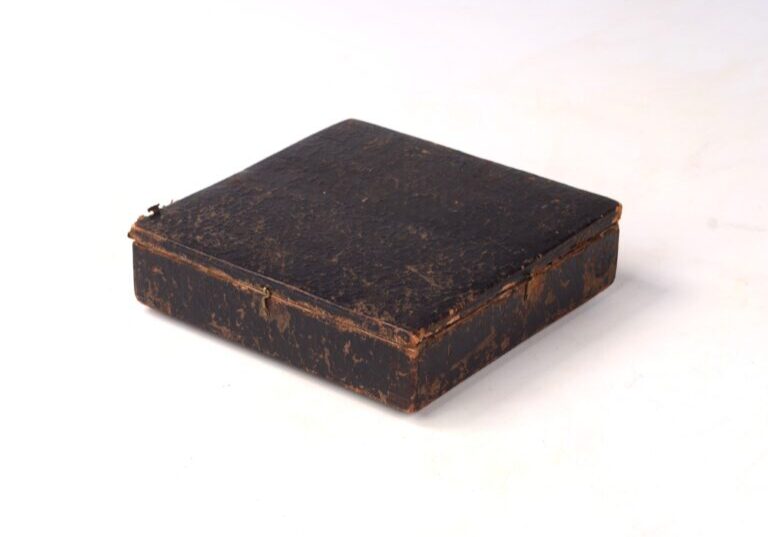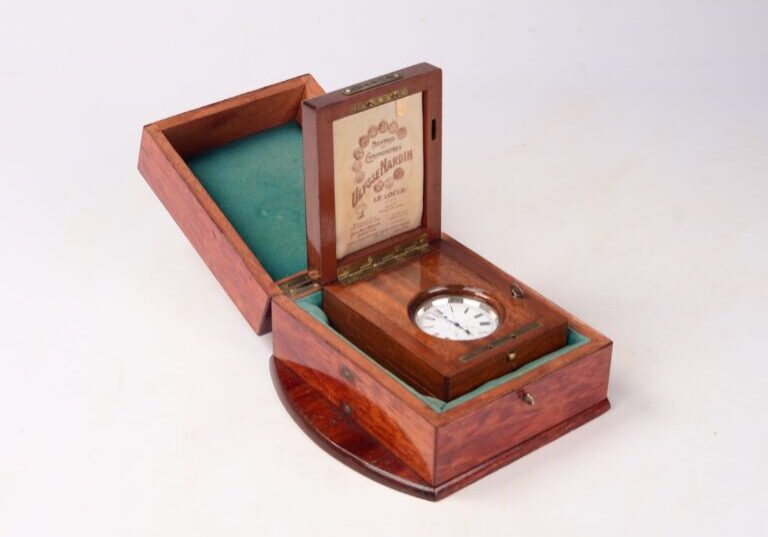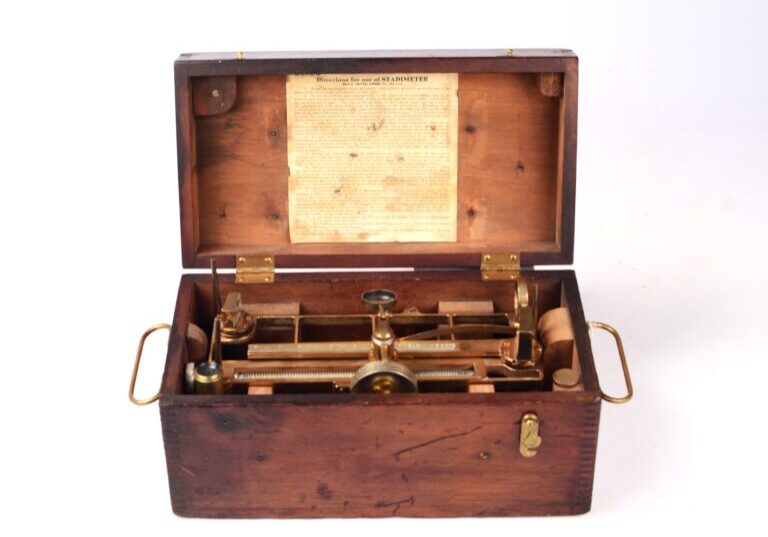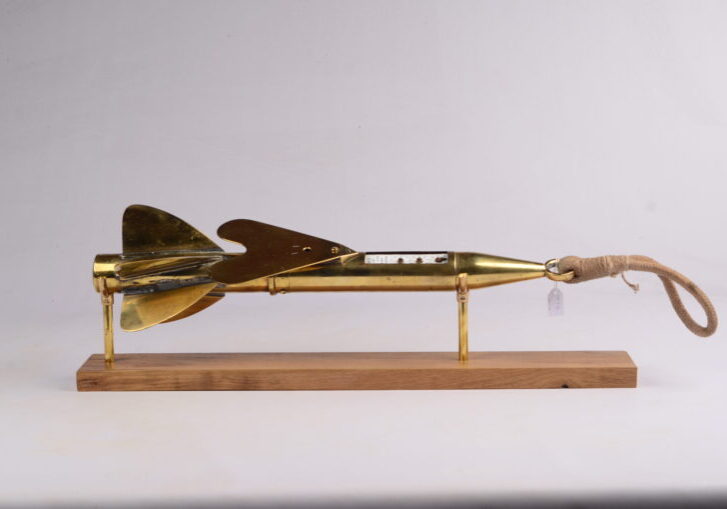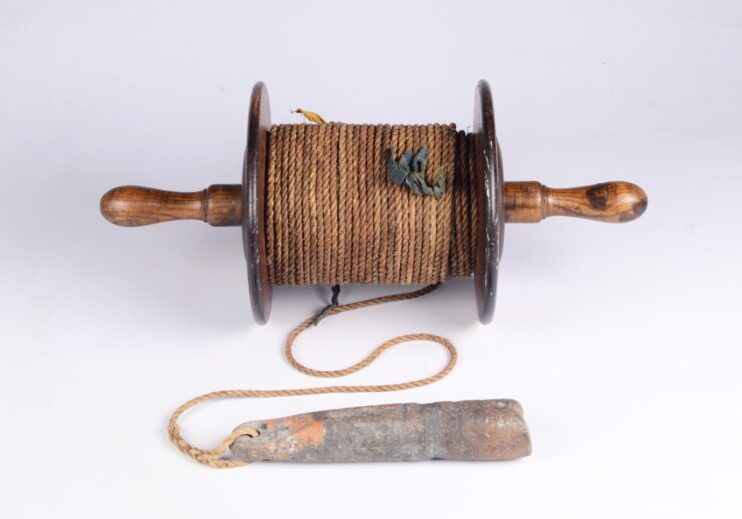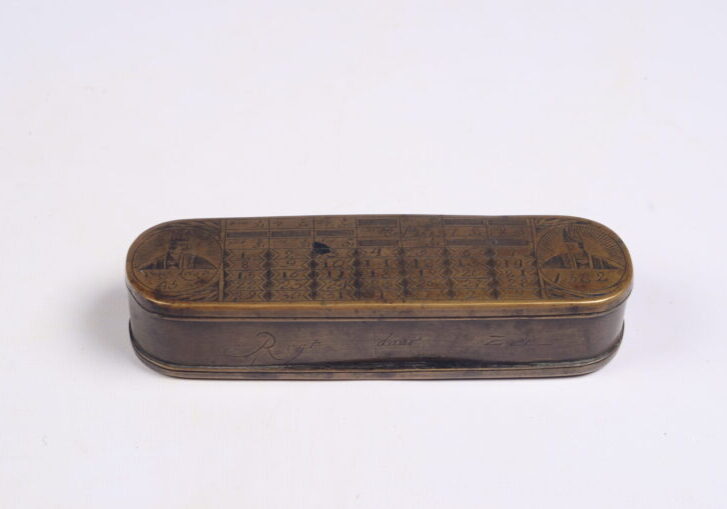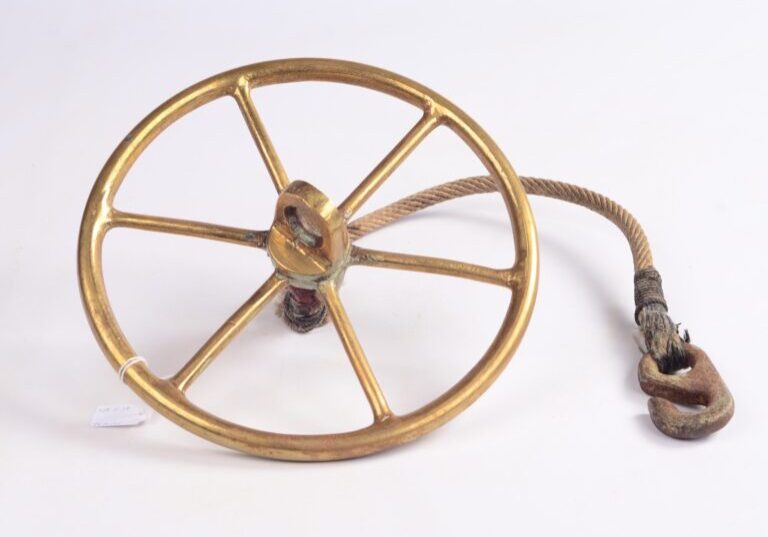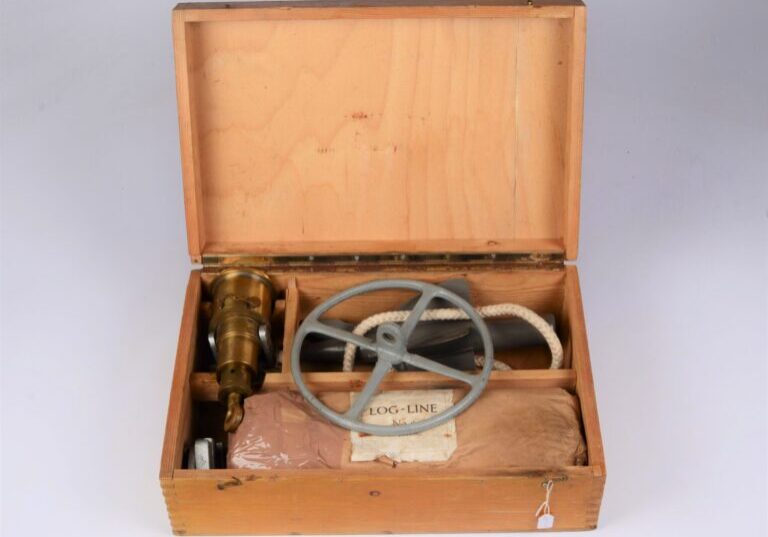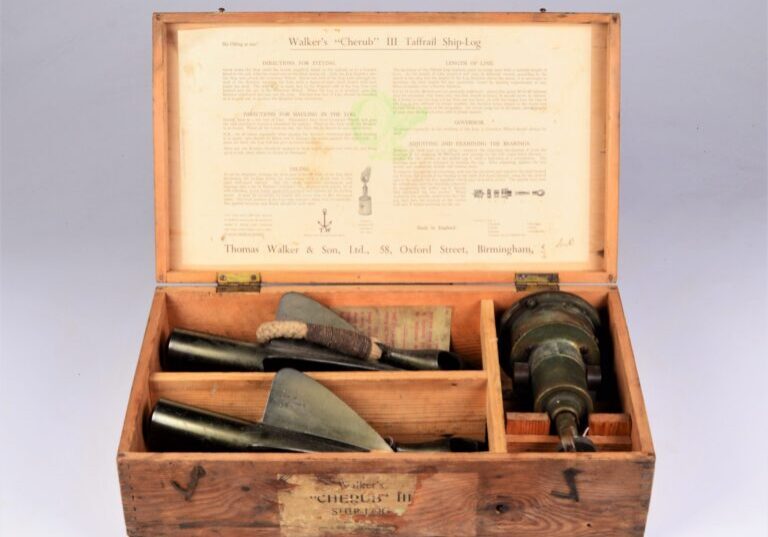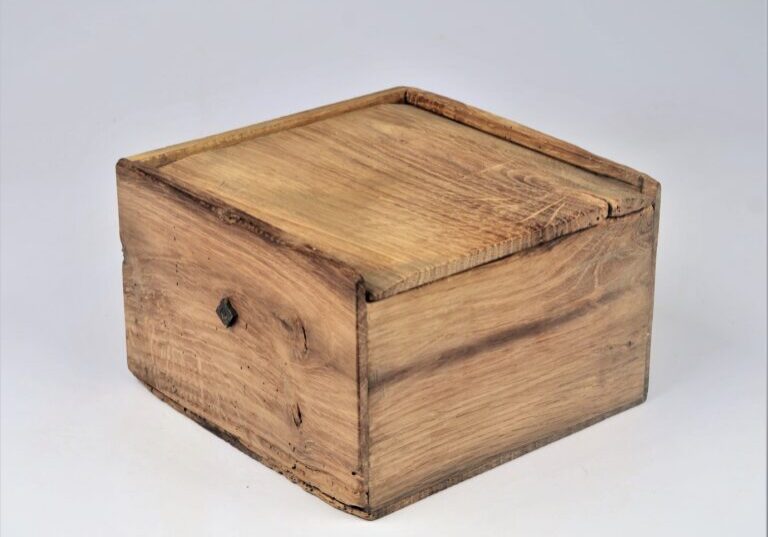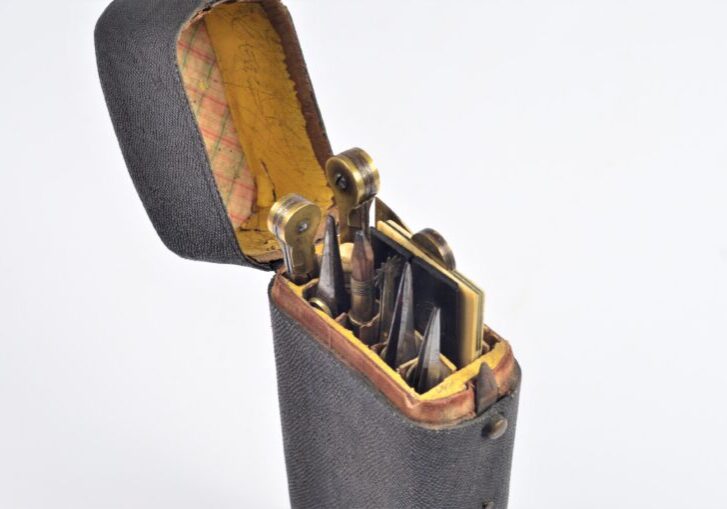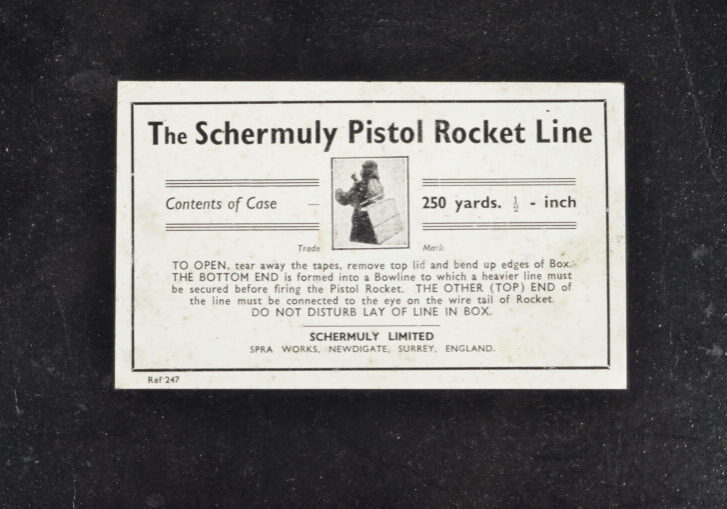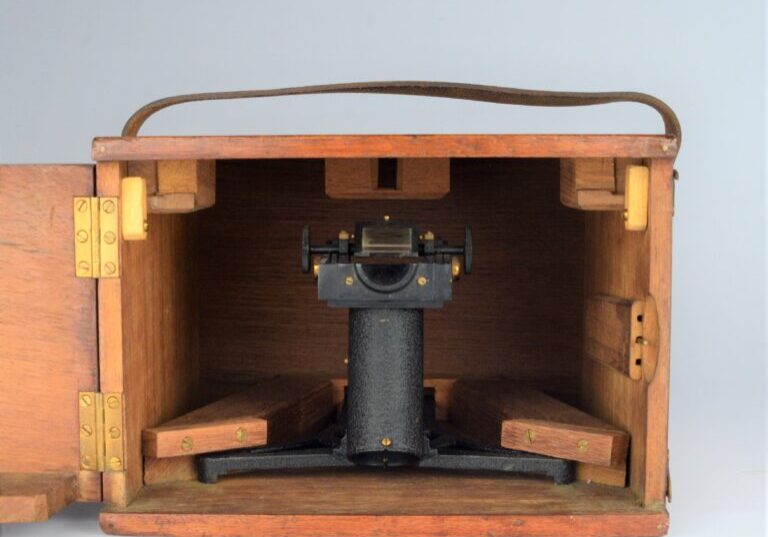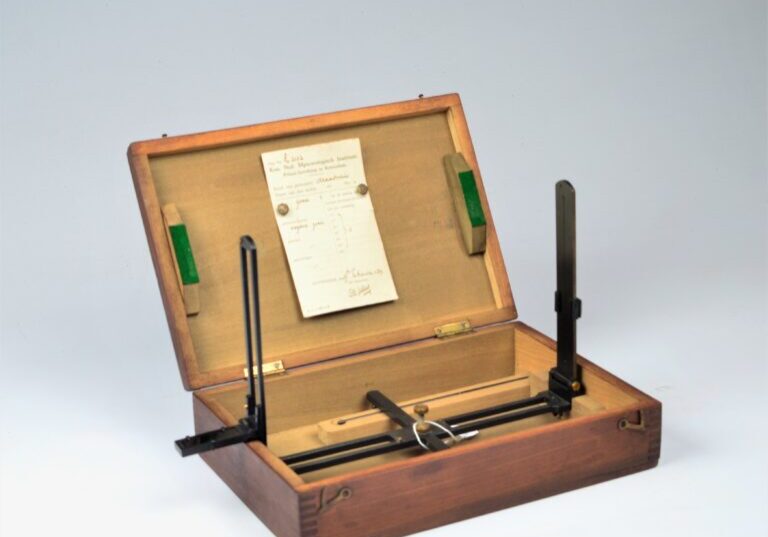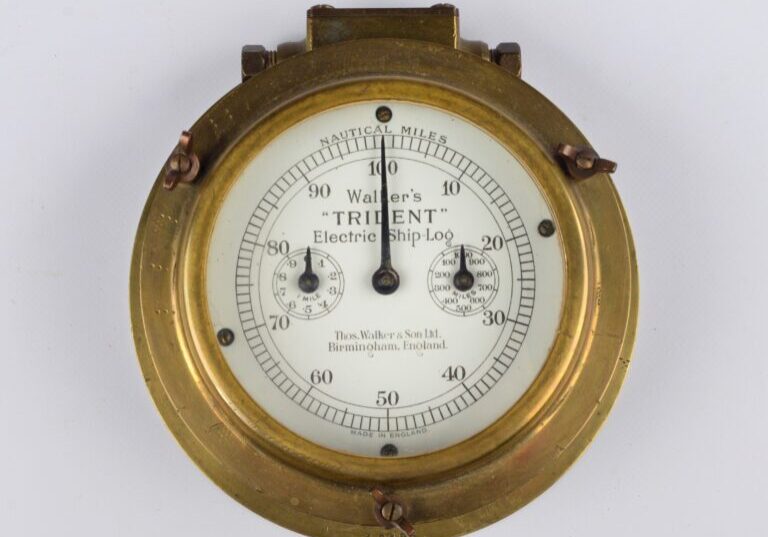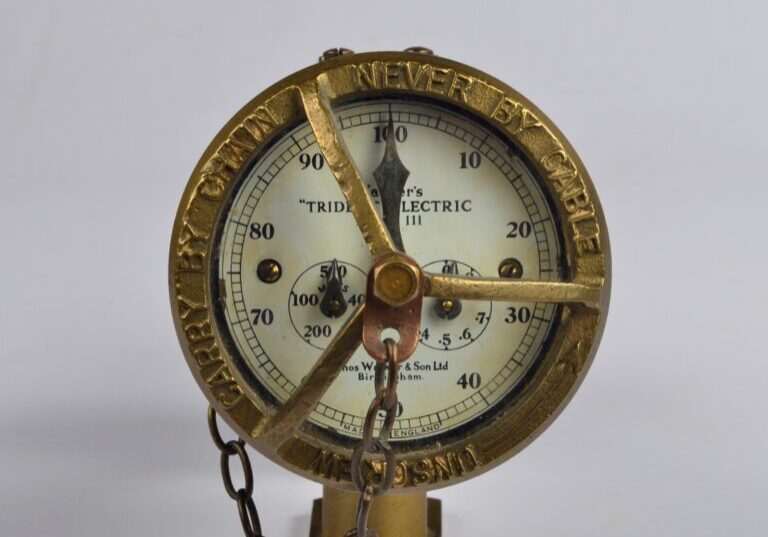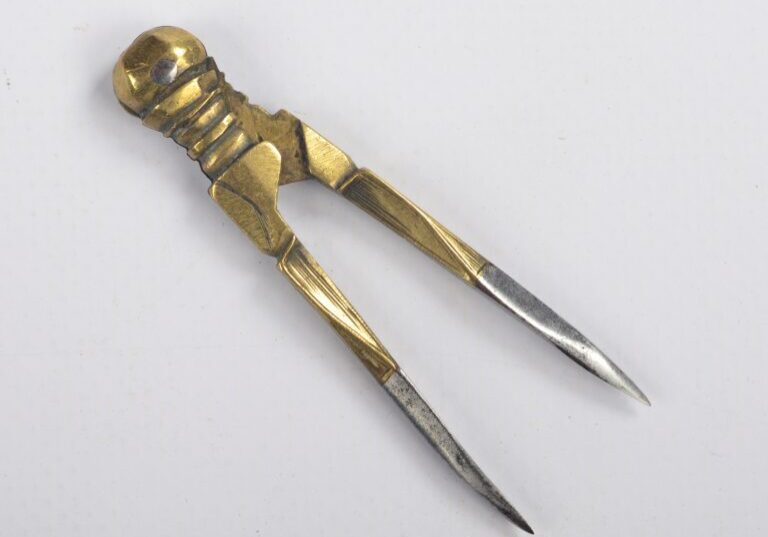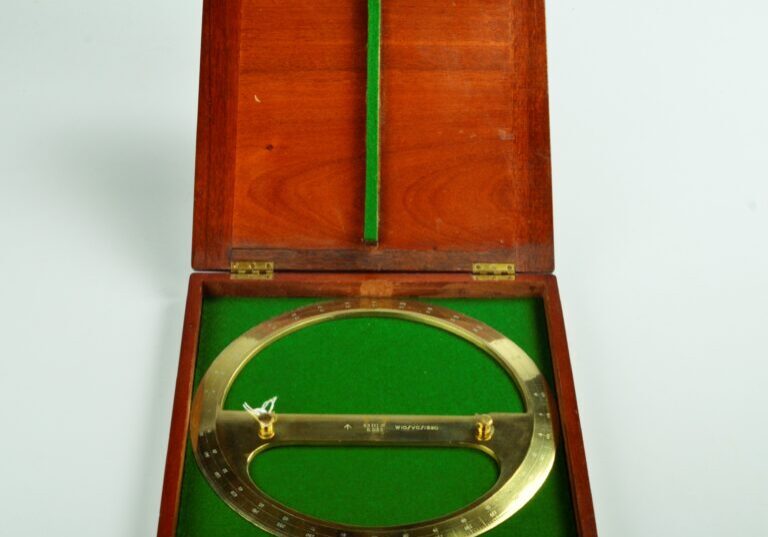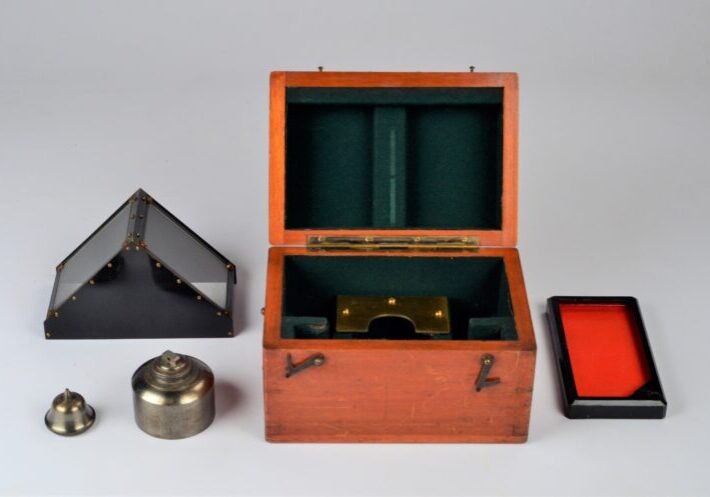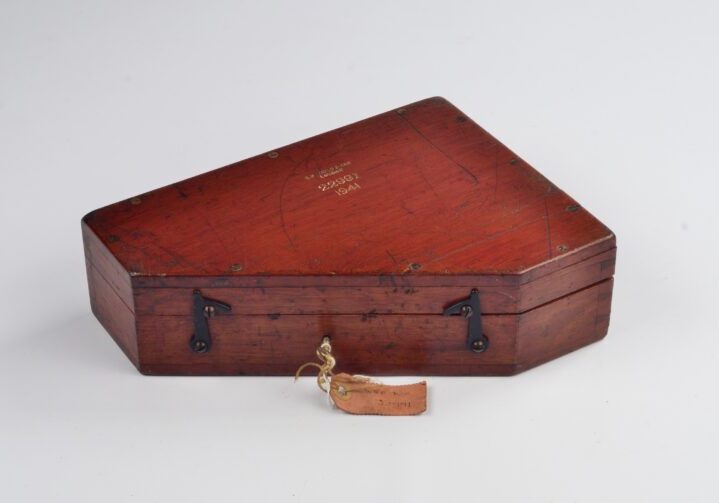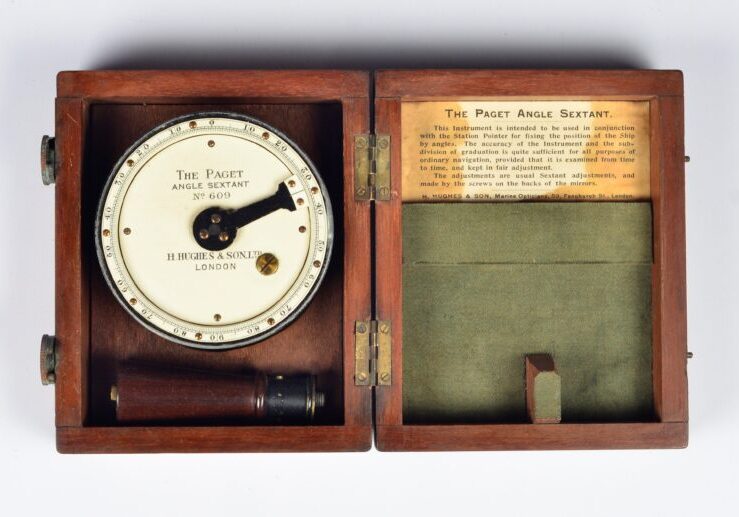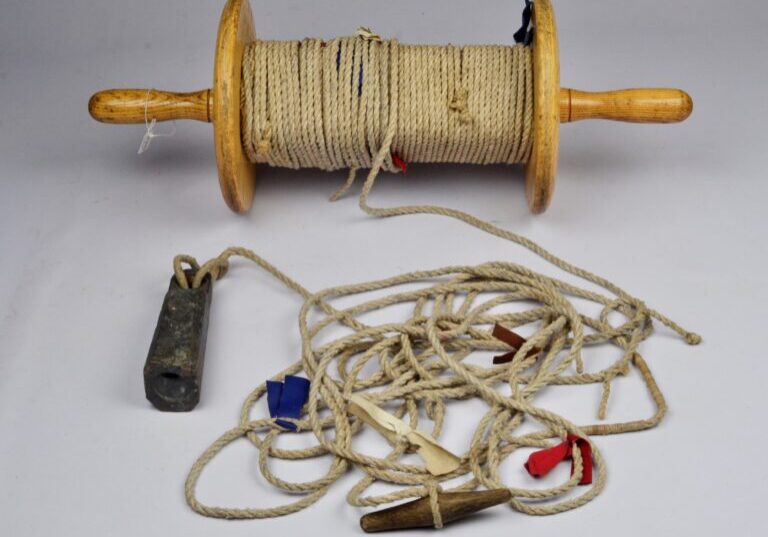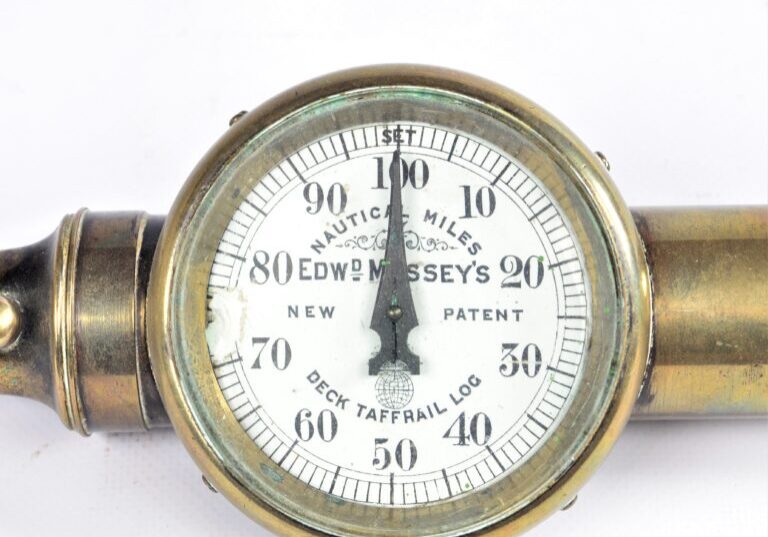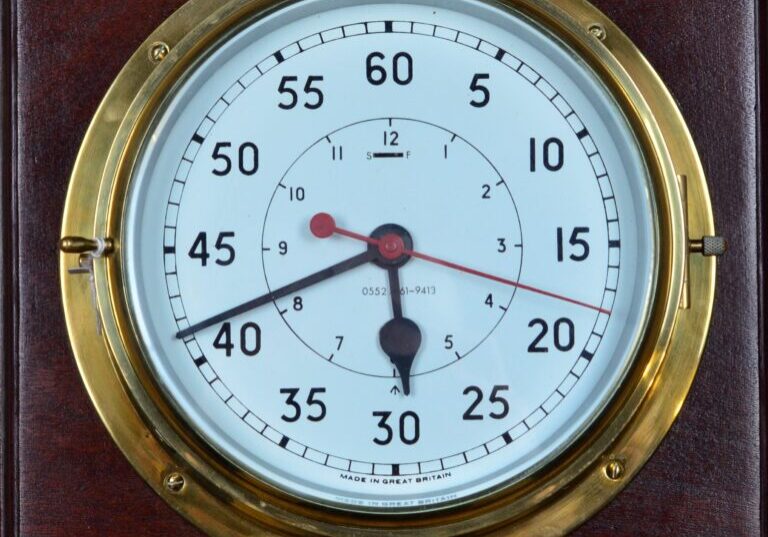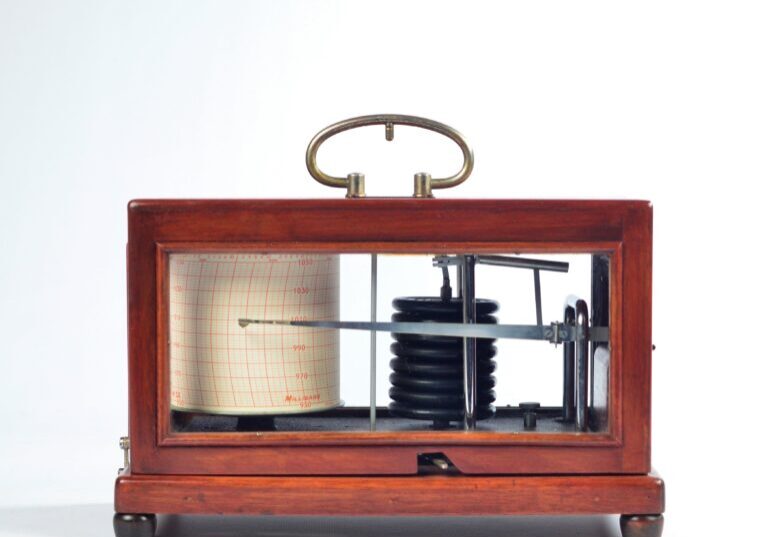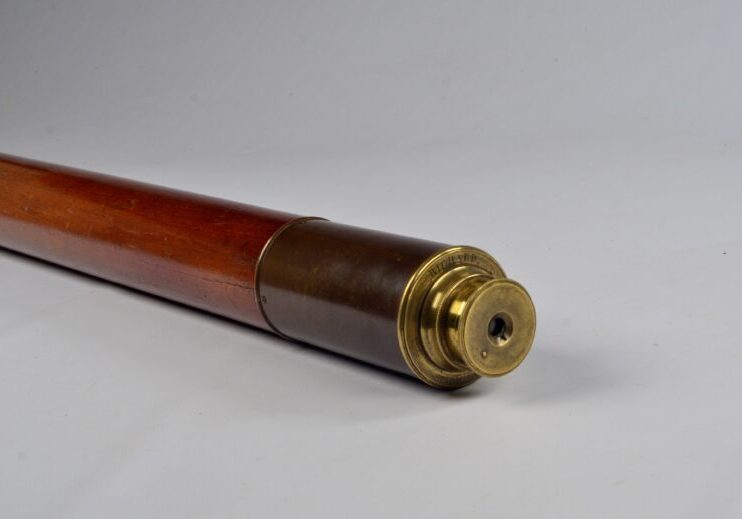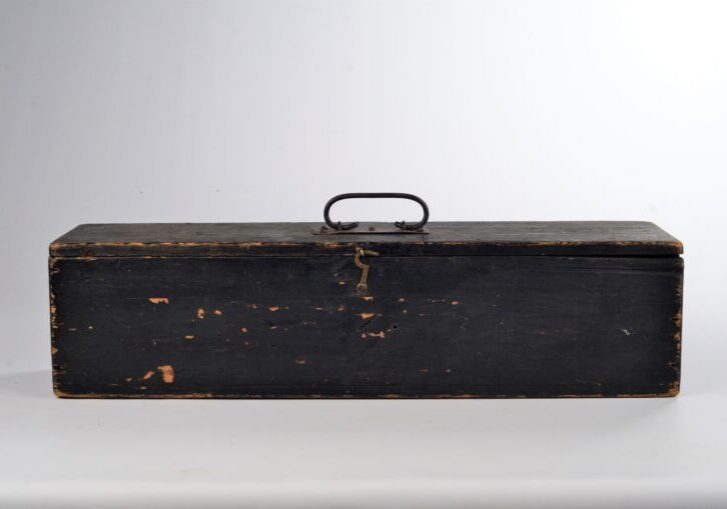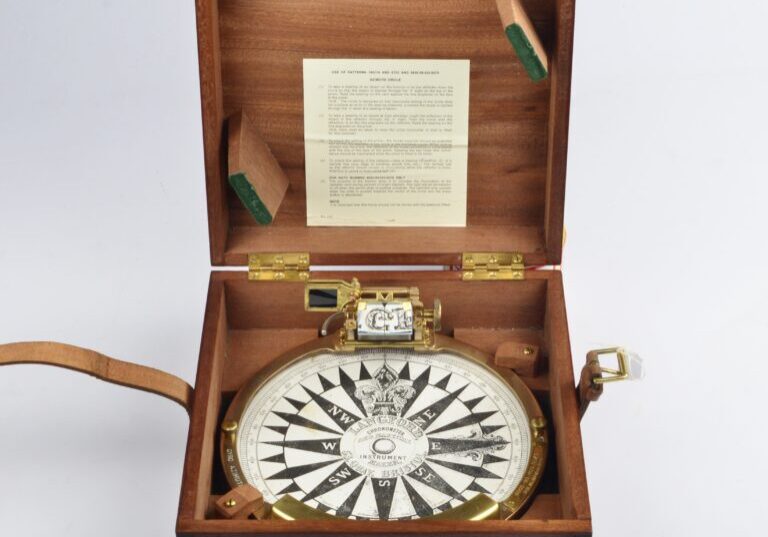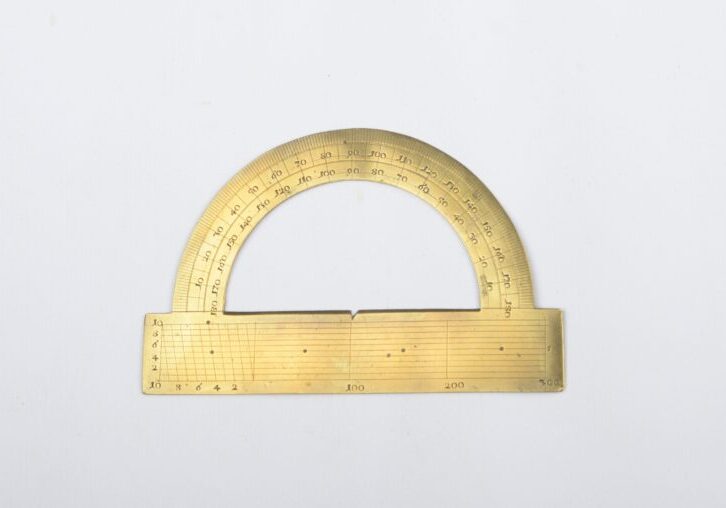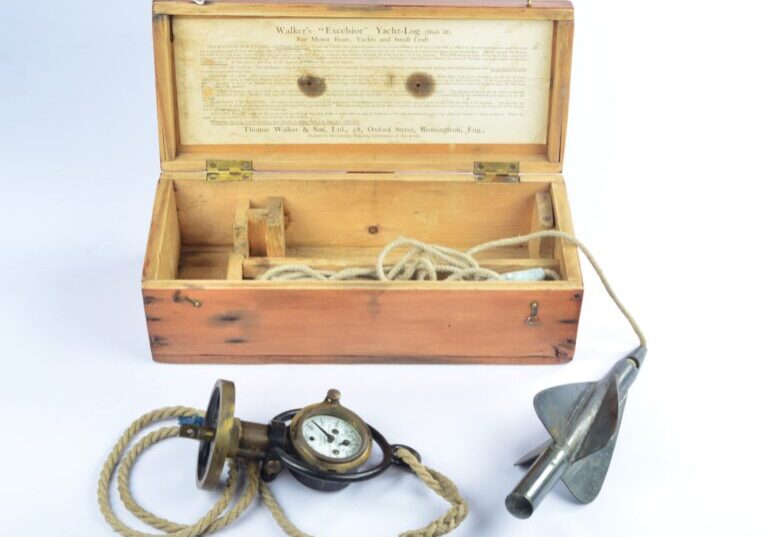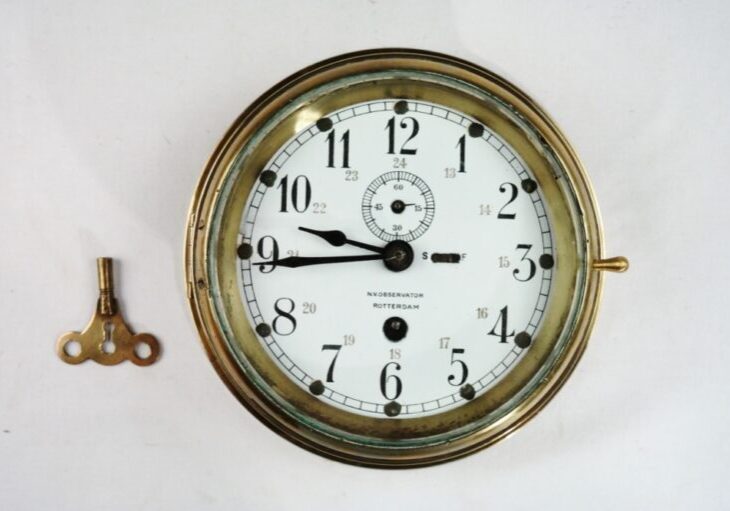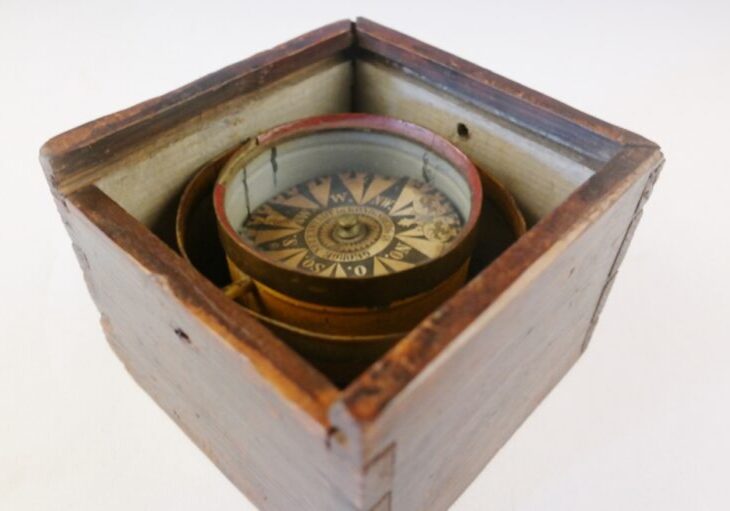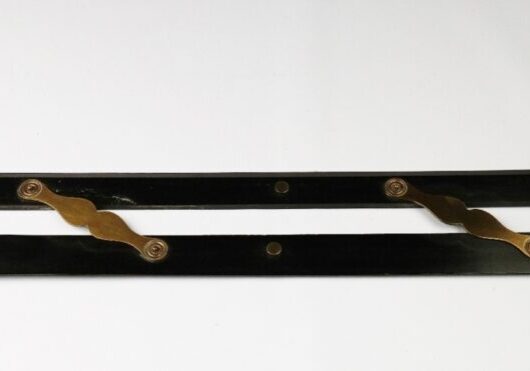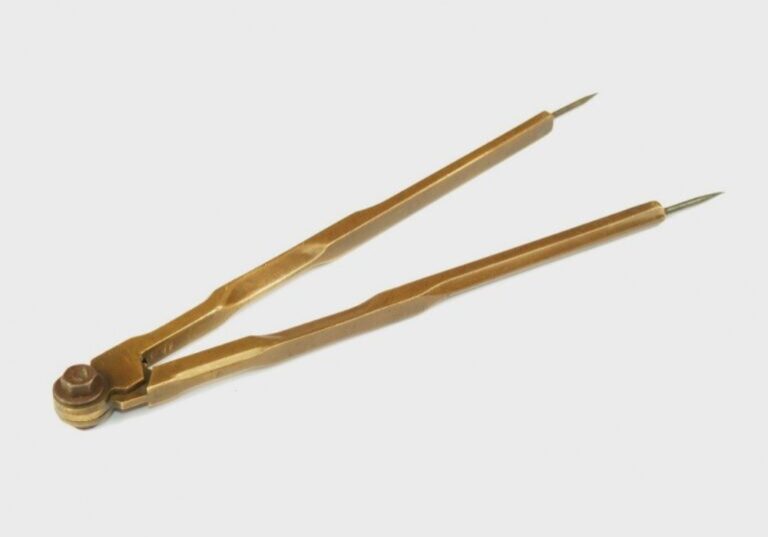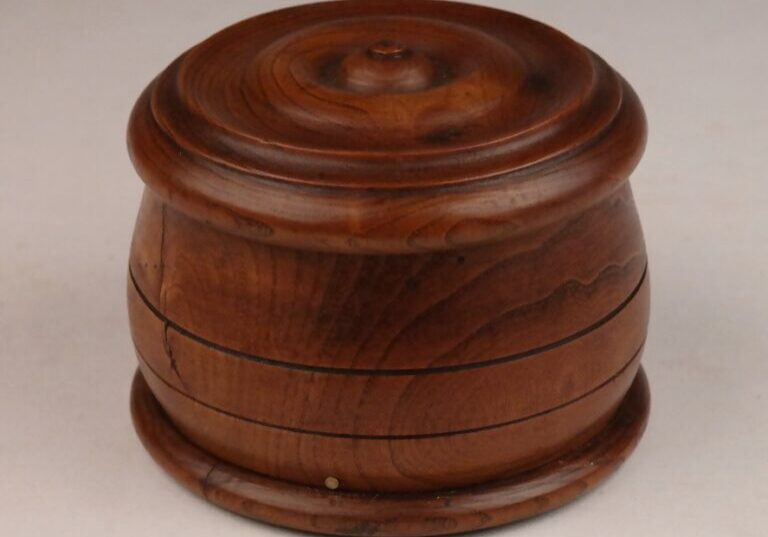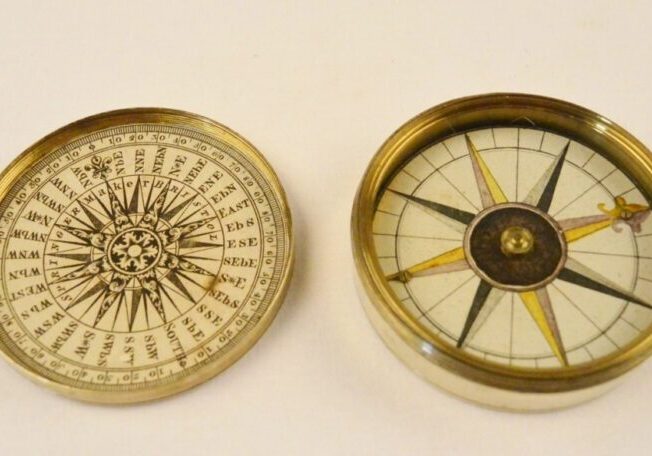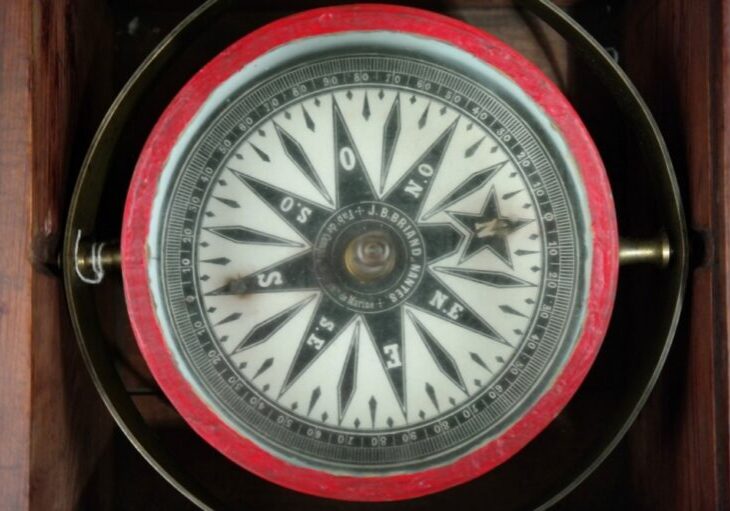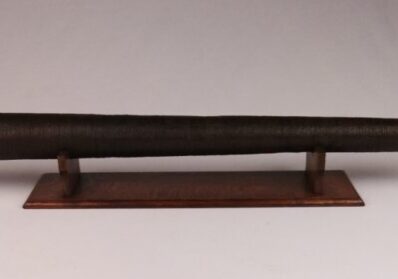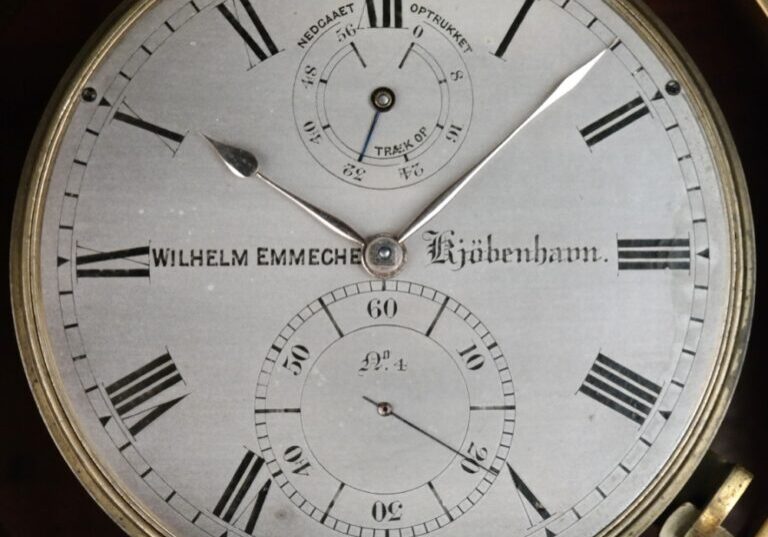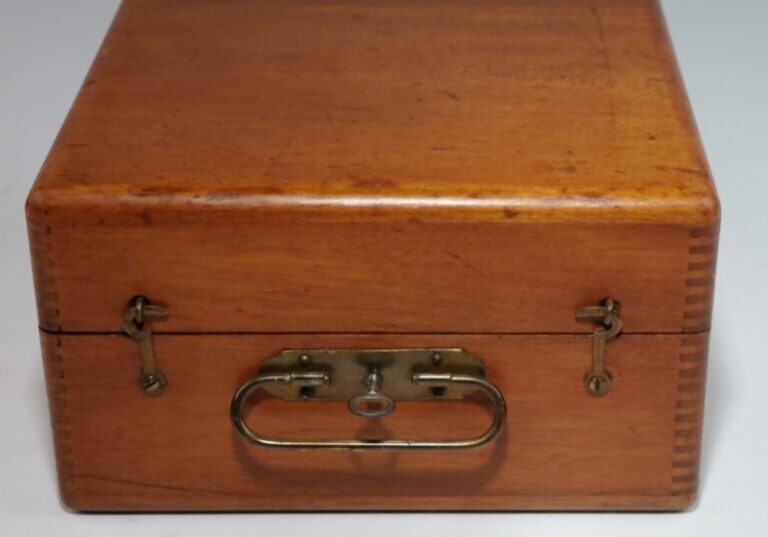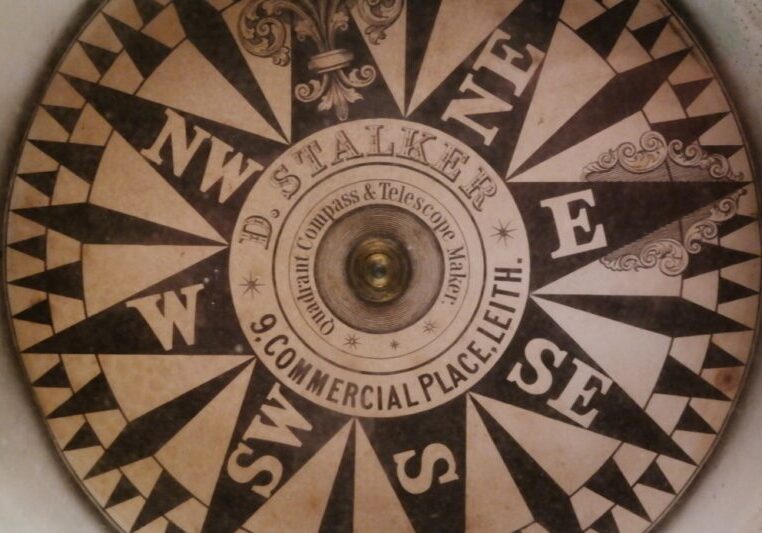Nautical instruments
This part of the collection includes mainly navigational instruments from the early sailing period, the time when ships were made of wood and men were made of steel.
The traverse board was used to make dead reckoning. During the watch at sea, the sailed course was recorded every half hour and the speed every hour. At night in the dark this could easily be done by touch. Taking current and tide into account, the position was charted with these data after or during the watch.
The circular part has 32 compass points and eight concentric circles with holes at the intersections. In the middle are eight cords with little pins of bone and wood. On the rectangular part, the miles traveled are recorded. They are indicated from 1 to 10 and tens of miles 1 to 9. Four rows below each other. One for every hour of the watch.
On this interesting traverse board the originally applied paint is still visible. One string is broken but all pins are there.
Catalogue: NM.7-20
Date: 1800 – 1850
D: 20 cm
HB: 37.5×2.5 cm
Signed: not signed
Origin: NW-Europe
Condition: in good and working condition, wear consistent with age and use
Timekeeping is very important on board of sea going ships. Correct time is essential for celestial navigation, to navigation using dead reckoning, to use tide tables and to regulate the watch system.
The nocturnal is an instrument to determine the correct time at nigth using stars of the Great Bear or Little Bear. They fell out of use with the advent of the marine chronometer, but were in use until the 19th century. Nocturnals are reliably accurate to within 15 minutes.
This instrument is made of boxwood with pierced heart-shaped handle and brass mounted polaris sight, at the back inscribed with IC. It is beautifully engraved. At the back a compass rose and table with the bearing of certain stars located in the Little Bear and Great Bear, relative to the Pole star. Conceived by Michel Coignet in 1581, nocturnals are really simple analogue computers and delightfully simple to use. You set the date with one ring, point it at the North Star using the hole in the centre and then swing the pointer to the Great or Little Bear (“both bears” on the handle) to read off the time.
Catalogue: NM.7-18
Date: early 1700
L without arm: 22,5
D: 11.7 cm
Middle point/arm: 20.7 cm
Signed: IC
Origin: probably English
Condition: in good and working condition, wear consistent with age and use
Graphometer or semicircle, with compass, with transversal vernier and double degree division and with ball and socket joint. The mainscale reads from 0 – 180 degrees on the outer edge and 180-0 on the inner edge. Pair of sights on the alidade with vernier on both sides. The frame is decorated with floral decorations. The compass rose with steel needle is divided in four quadrants of 90 degrees. The north direction of the compass is decorated with a fleur-de-lis.
Made by Michael Butterfield (c.1635 – 1735). Butterfield was an English instrument maker who had his workshop in the Faubourg St. Germain in Paris from before 1665 to 1724. His signature is engraved on the fixed limb.
In his time Butterfield was considered as one of the best designer of nautical and observation instruments. He was friends with Huygens. Peter the Great visited his workshop in 1717.
Catalogue: NM.6-34
Date: 1665 – 1724
HWL instrument: 10.5×23.5×16 cm
Signed: Butterfield AParis
Origin: France
Condition: perfect, original patin
Decorative nautical hour glass with hexagonal basis of wood and five wooden twisted pillars.
From the 17th century times of rise and fall of the sun and moon were known for the different latitudes. But until the invention of the chronometer, the seaman used the glass for the intervening hours. The glass was turned every half hour which was announced on the bell with the corresponding number of strokes.
To prevent moisture of the sand, the connection between the two glass balls was sealed tight with sealing wax and secured with crossed ropes.
Catalogue: NM.7-16
Date: appr. 1800
HD: 23.5 x 12.5 cm
Signed: not signed
Origin: continental
Condition: in working condition, wear consistent with age and use
The traverse board was used to make dead reckoning. The circular part has 32 compass points with eight holes on each point. In the middle are eight cords secured with little pins. The pins are made of copper. The cardinal regions are marked N, NO, O, SO, S, SV, W, NV. The incorrectly indicated SV was later corrected.
During the watch at sea, the sailed course was recorded every half hour by placing a pin on the sailed course at the circular part. On the rectangular part, the miles traveled are recorded. They are indicated from 1 to 12 and 1/4, 1/2, 3/4. Four rows below each other. One for every hour of the watch. At night in the dark this could easily be done by touch. Taking current and tide into account, the position was charted with these data after or during the watch.
Catalogue: NM.7-01
Date: ca. 1800
DH: 22×32.5×1.6 cm
Signed: not signed
Origin: Skandinavian
Condition: in good and working condition, wear consistent with age and use, some ropes and pins are missing
Marine chronometer of Parkinson & Frodsham with rare display in original mahogany box with key and brass mountings. Bone plate 355 numbered. Gimbal suspension, brass case, spring detent chronometer with helical hairspring. Signed and numbered 355. Original dial with rare rotating power reserve indicator for 8 days of power. Blued steel hands, large seconds indicator.
Chronometers by the important London manufacturer Parkinson & Frodsham are very rare and sought-after collectors’items.
Catalogue: NM.6-49
Date: ca. 1820
HWL box: 17x17x17 cm
D chronometer: 10 cm
Signed: Parkinson & Frodaham, 5 Budoe Row London, nr 355
Origin: England
Condition: very good, in working order
Attractive and well preserved Dutch dry card whaling compass from the early 1700s made by Leendert Valk, compass and sail maker, living at the Fransepad in Amsterdam. With hand-painted 32-point rose in black and white. North with fleur de lis, East – direction Jerusalem – with simple mark. On the rose, on either side of the North direction, the initials of the maker are indicated with LV. The compass is at that time delivered with removable bottom but without a cover.
On the inside of the binnacle is written in pencil, Steven Valk 1727. It is not clear who wrote this down and when. It may be a reference to Stephanus Valk, Leendert’s brother. Steven Valk is also a compass maker in the first half of the 18th century. He lived at the Haringpakkerij in Amsterdam.
Catalogue: NM.7-11
Date: 1712-1754
H: 7.5 cm
D binnacle: 13,5 cm
Signed: LV
Origin: Amsterdam, Netherlands
Condition: in good condition, slight damage to the rose due to corrosion
In contrast to a dry rose, the movements of the rose on a rolling ship in a liquid compass are damped in a liquid. This liquid consists of a mixture of alcohol and distilled water. A first attempt was introduced by E. Halley in 1690. The first serious design was patented in 1813 by the Briton Crow. Occasionally the Royal Navy placed it on smaller ships. In 1860 S. Richie designed an improved model that was generally accepted by the American Navy and from 1908 also by the British.
This azimuth compass is an early Dent Pattern 24 improved model in a very solidly constructed and polished mahogany case. Rare in this condition.
It is a nice complete example with 2 original sighting stylus (one spare) to be placed on top in the center when taking azimuth. With a bras funnel on top to top up the liquid filling and a leather carry strap. Due to the unfamiliarity with liquid compasses, Dent has provided instructions for use on the inside of the case.
Compasses like this one were first used aboard torpedo boats, later they found their way into the entire fleet. This ended the dominance of the Kelvin dry compass.
Catalogue: NM.7-09
Date: 1870-1880
HWL case: 20x26x26 cm
D compass: 20.3 cm
Signed: E. Dent & Co London No 44281, rose also signed Dent
Origin: England
Condition: complete and perfect; the leather strap is original, but not attached to the box
Horary quadrant of boxwood marked with Gunter scales. The brass sights are intact, the plumb is present but seems to be of later date. As is common with boxwood quadrants, the reverse has no nocturnal dial and is blank. The outer circle has a graduation of 0-90 degrees for height measurement. The sights are aimed at the celestial body, the plumb line then indicates the height to an accuracy of 1 to 2 degrees.
For astronomical observations the middle ring shows a representation of the sky with five stars are marked and named: Wing of Pegasus, Arcturus, Lions Heart, Bull’s eye and Vulture’s heart. Geometrical square in apex with the table of R.A’s of these stars. Latitud 51 30, the latitud of Greenwich.
Further to see: showing time and sun’s azimuth, equinoxes at 21 March and 23 September and linear shadow scales.
Copies of this quadrant are to find in the National Maritime Museum of Greenwich, in the Science Museum and in the British Museum.
Catalogue: NM.7-08
Date: ca.1675
HWL: 10x128x125 mm
Signed: not signed
Origin: probably English
Condition: excellent
Circle sextant, Borda circle, reflecting circle, circumferator, repeating circle, this instrument is known among several names. In Paris Chevalier de Borda published a description of his instrument in 1787. The enclosed 3rd edition with drawings of the Borda publication is from 1810.
Well preserved dry card and gimbaled brass tell-tale compass. The rose is made up of several layers of paper with 32 points. North with beautiful fleur de lis. On the rose, the letters E and W are painted over the old letters. Originally the rose will not be English. The inside of the binnacle is painted dirty white.
Catalogue: NM.6-20
Date: 1870 -1900
HD binnacle: 9.0 x 16.0 cm
Signed: not signed
Origin: unknown
Condition: perfect
Signal flags according to the International Radiotelegraph Conference in Washington in 1930.
During WWI, the international signal book from 1897 was found not to work properly between ships of different nationalities. It was therefore decided to thoroughly revise this book.
A fine and complete early 19th century shagreen cased set of chart work instruments.
All ten parts are original and present, including a boxwood sector and scale rule. Also made of brass, two dividers with complete and matching attachments for ink, pencil lines and dotting wheel, ink pen, brass protractor and brass mounted pencil. Brass bolts and lock.
Catalog: NM.6-02
Date: early 19th century
HWL: 17×7.5×3,5 cm
Signed: not signed
Origin: England
Condition: lock box worn, otherwise in good condition
Maritime artefacs
Lodestone mounted in a brass frame with carrying ring on top. With two pieces of steel at the bottom to increase the magnetic strength of the lodestone. French lilies on all sides.
Catalogue: NM.6-06
Date: 1600-1650
HWL: 68x71x53 mm, overall height with ring 130 mm
Signed: not signed
Origin: probably French
Condition: in excellent and working condition, wear consistent with age and use
After the astrhttps://archipel-img.com/wp-admin/edit.php?post_type=objectolabe and the Jacob’s staff, in 1595 John Davis invented the backstaff to determine the altitude of the sun at sea. His improved design became known as the Davis Quadrant. The observer stood with his back to the sun and didn’t have to look at the bright sunlight. The instruments has two concentric graduated arcs centered on the far end. The larger scale runs from 0 to 25 degress, the other one from 0 to 65. Together 90 degrees, a quadrant of a circle. On the edge of the small arc are placed secondary scribe marks, slightly offset to correct for the sun’s diameter of 16 arcminutes.
The backstaff remained in use until the late 1700s when the octant and sextant became the new preferred tools over the backstaff. The transversal nonius can be read accurate at two minutes.
This instrument is made of boxwood with an pearwood inlaid plate with the name of the maker in the main strut and with brass rivets. The scales are also made of pearwood. It has an original horizon vane. The other two vanes are exact copies of the Jonh Dupee backstaff, inhouse made of old pearwood. The lens in the shadow vane is specially made with the required power of 4 dioptres and a focal length of 20 centimetres. The lens concentrates a bright spot of sunlight on the horizon vane which allows the instrument to be used when clouds made the sun less bright. The vanes have brass pressure plates for holding them tightly in place on the degree arc. The sight vane has an inlaid brass pinhole sight. Decorative fleurs-de-lis and other decorative stamps are stamped in the frame. The transversal scale on the degree arc reads from 0° to 25° by 5 arcminutes, and reads to 1 arcminute along the fiducial edge of the sight vane. The graduation on the sixtyfive degree arc is from 0° to 65° by 1°.
Henry Gregory and his son, makers of nautical instruments, had their Navigation Warehouse from 1776-1783 at 148 Leadenhall, London. In 1783 they continued as Gregory and Wright and from 1789-1792 as Gregory, Gilbert and Wright (Webster database).
An identical instrument is in the collection of the Bristol Museum.
Catalogue: NM.5-34
Date: 1776-1783
HWL: 63.5×35.5×1.5 cm
Signed: H. Gregory near ye India House London
Origin: England
Condition: excellent, little wear consistent with age and use
The hand log was first described in 1574 (Sharp, p 5). It consist of a wooden chip with peg, the log line, a reel and a 28 or 14 second sandglass. The chip in the shape of a circle sector and weighted with lead on the arc, is fitted with two lines to the peg, the end of the log line forms the third. After a stray line of about thirty meters, the log line is equally divided into parts of 47 feet 3 inches (14.40 meters) to start with a flag or bunting. Thus at every 47 feet 3 inches knots are placed to denote the number of miles. The chip is thrown astern of the ship and remains static whilst the line is paid out and the ship sails away from it. The number of knots sailed out in 14 or 28 seconds indicates the speed of the ship in miles per hour or knots. Between every knot half knots are marked.
With this log a speed up to 5.5 knots can be determined. The starting point, the zero mile, is marked with a red flag and the first knot is marked with a leather vane. Half knots are indicated by simple lines without knots. The line has been repaired after a break or something like that.
The hourglass of 28 seconds in housed in a wooden house, 13 cm high.
Catalogue: NM.5-26
Date: ca. 1880 – 1900
LD reel: 55×24 cm (21.5×9.5 in)
Signed: not signed
Origin: unknown
Condition: in good and working condition, wear consistent with age and use

Nice quality single draw telescope with two bras tubes, sunshade and good optics. Eye and objective lensos with a protective shutter. The mainbody is clad with leather and has taken on a nice antique patina, polished over the years. Both lenses have a sliding lens protector. The window displays flags and pendants of the British Navy. Some signs of age and use.
The stand is new made of old oak of about the same age as the telescope.
Price of the stand is E 85,=
Catalog: NM.5-10
Date: ca. 1880
L with sunshade: 58 cm, extended 96 cm (resp. 23 and 38 in)
D objective side: 40 mm (1.5 in)
Signed: not signed
Origin: England
Condition: for its age, perfect; in working condition, wear consistent with age and use
An interesting three mirror octant with Vernier nonius, made by or for Robert Williamson in 1768.
The first octant was created by Hadley in 1731. In Great-Britain and North-America the instrument was called the Hadley’s quadrant to distinguish it from the Davis quadrant. Hadley got in 1734 a patent for eleven years. Immediately after it came to an end other instrumentmakers started with making octants.
This octant is made of mahogany. The graduated scale is made of ivory with a Vernier nonius. The engraving is made by hand. At the graduation every degree is divided in parts of 20 minutes, The Vernier nonius is divided in twenty equal parts. The accuracy of reading with this nonius is one minute. A mistake is made on the vernier. Where 15 is engraved it should be 5.
The lower horizon mirror and peepsight were used for backward observation. As the horizon just below the sun was invisible, in this way it was possible to use the opposite horizon. The instrument was used back to front. The observer had the sun in his back. The sunshades moved to the lower position.
This beautiful instrument with nice patin, is complete and in a good condition, with three mirrors, two peep sights and two sunshades. On the backside three brass legs and the adjusting-screws.
The mirror table of this octant is also made of mahogany. Octants of a later date have brass ones. The nonius does not have a double scale anymore, but still has the width of a double scale.
Catalog: NM.2-34
Date: 1768
HW: 50×42 cm (19.8×16.5 in)
Radius (rotation axis till nonius): 43,5 cm (17.2 in)
Signed: * Robert Williamson 1768 *
Origin: England
Condition: for its age, very good, minor crack in the graduation left under, two cracks in one of the sunshades
Dry card compass in a copper bowl. The compass is gimbaled mounted in a wooden case of oak. Sliding cover is missing. The inside of the bowl is painted white with lubber’s line. On the rose 32 points and the name of the maker. On the rose, north with fleur de lis. In the middle of the rose a bras top with sapphire.
At de underside of the rose is a heavily compass needle mounted with pins on the rose. The rose is not compensated for magnatic variation.
Made by Dirk Barend Selter, compass maker from 1840-1899, Binnen Bantammerstraat, Amsterdam. The details of the compass suggest an early specimen.
Catalogue: NM.7-06
Date: 1850-1870
WL case: 14x19x19 cm
D compass: 13,5 cm
Signed: + D.B. SELTER + AMSTERDAM
Origin: Netherlands
Condition: in good condition, wear consistent with age and use
Early station pointer with manual in mahogany case for coastal navigation. Made by Hughes, London.
The instrument is completely made of brass and does not yet have a silvered scale as with the later species. The scale is divided in half degrees and reads by two verniers to one minute of arc. The diameter of the circle is 162 mm.
Navigators employed a sextant or bearing compass to measure the angles between their position and each of three known landmarks. They then placed the station pointer on their chart and set its arms to the observed angles. The centre of the protracting circle on the station pointer would then show the position of the ship.
Catalogue: NM.6-39
Date: ca. 1870
HWL case: 55x500x192 mm
Signed: H. Hughes & son Ltd; 59 Fenchurch St. London; No 1920
Origin: England
Condition: in good and working condition, wear consistent with age and use
1.
Brass quadrant in cardboard box. The instrument is used for angle measurement in the horizontal plane as well as for height measurement. For the latter, a plumb line has been added that can be placed in the appropriate slit. The lid of the box is hinged on one side and can be secured on the other sides with three brass hooks.
A grid has been applied to the square plateau, which is subdivided into 10 x 10 numbered areas, which in turn are subdivided into 4 areas each. The quarter circle has 2 degree divisions from 0 – 45 degrees.
Altitude quadrants are mathematical instruments that were used for simple surveying tasks.
Catalogue: NM.7-02
Date: ca.1850
HWL box: 4.7x17x17 cm
Signed: not signged
Origin: Sweden
Condition: in good and working condition, wear consistent with age and use, the top of the plateau is slightly corroded
2.
Very rare surveyor glass plate with rectangular pattern in marbled cardboard box for field map making. Made by P.A, Höglund, Stockholm.
Another Lantmätarepollett of Höglund is tot see in the Tekniskamuseet in Stockholm: https://digitaltmuseum.se/021026349071/lantmatarepollett.
The glass plate has been cleaned occasionally.
Catalogue: NM.7-02
Date: ca.1850
HWL carton: 0.8×16.5×17 cm
Signed: P.A. Höglund, mathematisk Instrumentmakare,
Stockholm, Norra Tullportsgatan no 65
Origin: Sweden
Condition: in good and working condition, wear consistent with age and use
At sea, having the right time on board is essential to be able to make a position.
Very rare and large deck watch in a case of stainless steel made by Ulysse Nardin. Special about this specimen is the electrical mechanism by which the watch can be used as a master timekeeper or mother clock. Stored in a three tier deck box with key and carrying case lined with green baize. Both made of mahogany. The white enamel dial with subsidiaries for seconds and power reserve. The 24 is marked in red to indicate when the watch should be wound. Blue steel hands. Stainless steel case with electrical contact in the band and sprung electrical contacts and circuitry under the mahogany cover. Case and watch numbered 124500. The closing lid of the watch and the inner lid are numbered 669338.
Information of Ulysse Nardin about this chronometer: “About the closing lid number we don’t have information. Usually the wooden case has the same number as the movement, but sometimes they deviate. The electric device was to make this chronometer like a “mother clock”. Once connected to another device it could show 1/100th of seconds!”
From La Collection exclusive des Chronomètres de Marine, publication 1947, page 10 and 11.
Catalogue: NM.6-50
Date: 1943
HWL: 12×21.5×19.5 cm
Diam: 65 mm
Signed: Ulysse Nardin, Lockle Swiss, 124500
Origin: Switzerland
Condition: excellent
Early stadimeter made of brass in full working order. It’s complete with box of mahogany and adjustment instructions in the lid. That the instrument is made of untreated brass, the case is made of mahogany and the no. 352, indicates that it is a very early instrument. Felt has not yet been used.
The stadimeter or optical range finder, was developed in the 1890’s by Bradley Allen Fiske and designed to determine the distance to other warships. Like a sextant, the stadimeter uses a system of mirrors to measure the angular distance of two ends of a distant object (e.g. height of a light house, length or height of a vessel). The difference with the sextant is that the user can set a reference scale to a known dimension of that distant object. The stadimeter allows the user bring the two ends of the known object into coincidence, after which the distance to the object can be read from its drum micrometer.
Catalog: NM.6-52
Date: 1918
HWL: 12x27x13 cm
HWL case: 16x32x17 cm
Origin: USA
Condition: in good and working condition, wear consistent with age and use
Signed:
STADIMETER
U.S. NAVY. BUREAU OF ORDNANCE
Mark III, MOD 1, ND. 352
1918 INSPEC. C.H.D. (ANCRE)
MADE BY KEUFFEL & ESSER CO.
NEW YORK
From the 17th century onwards people had made many attempts to devise a mechanical log which would automatically record the ships distance done.
Edward Massey invented a mechanical log in 1802 with four blades which was used by the Admiralty from 1807-1815. When dragged behind the ship the log vins rotates and the revolutions were transformed in miles on the dials, to be read after the log was brought in. The design of Massey was further refined by Thomas Walker and Son, who took out a patent for the A1 Harpoon Log in 1861. Heath & Co., instrumentmakers in London from 1845-1910, made only a few harpoonlogs based on Walkers patent of 1861, also with stabilizer. (more…)
A ship-log records the distance travelled through the water. With the time in hours between the observations, it gives the ship’s speed in knots.
A very rare and complete yachting taffrail log. Hardly used. With clock, line, rotator, sinker weight and two shoes in a mahogany case. The log is fixed on a shoe at the stern of a ship. The recorder would have been connected with a line to the rotor at the end of the line. The governor wheel is fitted in an open end housing. The enamel face with two dials.
Catalogue: NM.6-36
Date: appr. 1950
HWD case: 16x36x22 cm
Signed: Loch Vion yachting, case and rotator: E. Vion, Paris
Origin: France
Condition: in very good condition, wear consistent with age and use
Course Corrector of the United States Maritime Commission fixed in original wood box. The divice is a ten inch disk of three rings and has an indicator arm with two thumb screws.
The device is used to assist calculating true, magnetic or compass course base upon variation and deviation.
Catalogue: NM.6-35
Date: 1940 – 1950
HWL case: 4.5x30x30 cm
D corrector: 25.5 cm
Signed: not signed
Origin: USA
Condition: in good and working condition, wear consistent with age and use
Dry card compass in a linden bowl with lid. With a brass top the rose can move freely on a peg. The inside of the binnacle is painted dirty white with lubber line.
Catalogue: NM.5-30
Date: 1800 – 1830
HW bowl: 10 x 13 cm
D rose: 10 cm
Signed: not signed
Origin: England
Condition: good
A lifeboat set consisting of:
- complete set of six boat charts of all oceans in summer and winter time
- a wrought iron grappling hook with line.
- a linen oil bag
- a parallel ruler
- a divider and pencil
The charts are mounted on a linen back.
Oil bags were carried as part of the ship’s lifeboat equipment and were rimarily intended to be deployed in conjunction with a sea anchor to mitigate the effect of seas breaking inboard when hove-to or running before a swell. Original quality.
For the grappling hook an old plumb line was used for the line. The colored markers are still present.
Catalogue: NM.7-13
Date: WWII era
Signed: Admiralty London
Origin: England
Condition: in good and working condition, wear consistent with age and use
Widely used deeplead of 10 lbs with a leadline on a reel to find waterdepth and type of soil. The length of the line is 25 fathoms. The first five fathoms are marked with blue tarlaulin flag around the fathom. Thereafter every two and a half fathom is indicated with a yellow flag.
The bottom of the lead is provided with a hollow to put in some fat. Adhered soil gives an indication of the structure of the seabottom. The reel is made of oak.
Catalogue: NM.6-30
Date: 19th century
LD reel: 53×23 cm
Signed: not signed
Origin: unknown
Condition: perfect, working and wear consistent with age and use
Large and heavy electrified taffrail log with plug connection and fly wheel in original case. Cherub rotator used. The enamel scale has three registers.
The large one up to 100 miles, two smaller up to 10 and 1000 miles. Brass and glass guarded face cover unscrews to reveal the dials. Maker’s name engraved. Serial number AF9136. Lid with screws and labels of Walker’s, of the Union-Castle Mail Steamship Co. Ltd. and of Christie & Wilson Ltd.
Catalogue: NM.6-26
Date: ca. 1958
DL: 12×29 cm
Case: 25x53x35,5 cm
Signed: Walker’s Commodore Electric Log, AF9136
Origin: England
Condition: in very good condition, wear consistent with age and use
Dutch seaman’s tobacco box of Pieter Holm, also known as the Dutchman’s Log, with a perpetual calendar on the top of the lid and a ship’s speed table on the bottom.
In a publication of 1748 Holm claims to have devised this table in 1729. The top of the lid is further adorned with simple vignettes portraying Julius Caesar and Pope Gregory XIII, who respectively in 45 BC and AD 1582 introduced the Julian calendar and the Gregorian calendar. The bottom carries a simple vignette of a person with a globe and a pair of dividers with the year 1497 who is tentatively identified as Amerigo Vespucci. On the bottom a short tekst in old Dutch, den eeuwig durenden almanack (the perpetual almanac). And on the frontside, Regt door Zee (Sail a Straight Course).
It’s an original box of 1729, see the lid bottom right.
Catalogue: NM.6-25
Date: 1729
HWL case: 3×15,5×4,7 cm
Signed: not signed
Origin: Netherlands
Condition: perfect condition with small signs of use
The spoked fly wheel is introduced in 1878 by W. Waring. Subsequently applied in large quantities by Walkers and others. This early hand-made brass item is possible made by Waring.
Catalogue: NM.6-18
Date: ca. 1878
D: 22.5 cm
Signed: not signed
Origin: poss. England
Condition: perfect with small signs of use
A finely made ship’s log to measure the distance covered through the water within a certain time. Distance divided bij the time in hours, gives the speed in knots through the water.
A nice and complete Mark III in case with two spare windows, two rotators, hook and gimbal foot. Three dials on ennamel face, the larger registers up to 100 miles, the smaller two register up tot ten and 1000 mile. Two four bladed rotators stamped with anchor motif and initials TW.
The production of the Mark III commenced in 1930 and ceased in 1994. Details and serialnumber suggest a manufacturingdate circa 1940.
Catalogue: NM.6-17
Date: ca. 1940
L log: 24 cm
Diameter log: 11.7 cm
Log signed: WALKER’S CHERUB Mark III, serialnumber AG7722
Origin: England
Condition: good and complete
A pair of proportional dividers with fine adjustment made by Royer à Paris. The instrument is signed by the maker. The box is closed with beautiful brass hooks.
Catalogue: NM.6-42
Date: ca. 1880
HWL: 2.5×22.5×3.3 cm
Signed: Royer Ft de Compas, Rue de l’Ancienne Comedie 12, Paris
Origin:
Condition: in good and working condition
A finely made and unused ship’s log to measure the distance covered through the water within a certain time. Distance divided bij the time in hours, gives the speed in knots through the water.
Nice and complete log with rotator, two gimbal feet and line in case. Two dials on ennamel face, the larger registers up to 100 miles, the smaller one up tot 10 miles. The log does not appear to have been used.
Catalogue: NM.6-16
Date: ca. 1950
L log: 24.5 cm
Diameter log: 9 cm
Log signed: Cassens & Plath Logge
Origin: Germany
Condition: unused, good and complete

Dutch seaman’s tobacco box of Pieter Holm, also known as the Dutchman’s Log, with a perpetual calendar on the top of the lid and a ship’s speed table on the bottom.
In a publication of 1748 Holm claims to have devised this table in 1729. The top of the lid is further adorned with simple vignettes portraying Julius Caesar and Pope Gregory XIII, who respectively in 45 BC and AD 1582 introduced the Julian calendar and the Gregorian calendar. The bottom carries a simple vignette of a person with a globe and a pair of dividers with the year 1497 who is tentatively identified as Amerigo Vespucci. On the bottom a short Dutch text, geen kunst maar rijk, dan kan men verlieze, daarom is kunst van rijkdom te kiesen. (no art but rich, then one can lose, therefore art of riches to choose). And on the frontside, Regt door Zee (Sail a Straight Course).
The box is of 1751, see the lid bottom right.
Catalogue: NM.6-15
Date: 1751
HWL case: 3x17x4,7 cm
Signed: not signed
Origin: Netherlands
Condition: perfect with small signs of use
A finely made ship’s log to measure the distance covered through the water within a certain time. Distance divided bij the time in hours, gives the speed in knots through the water.
Mark III in case with two spare windows, two rotators, hook and gimbal foot. Three dials on ennamel face, the larger registers up to 100 miles, the smaller two register up tot ten and 1000 mile. Two four bladed rotators stamped with anchor motif and initials TW.
The production of the Mark III commenced in 1930 and ceased in 1994. Details and serialnumber suggest a manufacturingdate circa 1940.
Catalogue: NM.6-14
Date: ca. 1940
L log: 24 cm
Diameter log: 11.7 cm
Log signed: WALKER’S CHERUB, serialnumber AC3586
Origin: England
Condition: good and complete
Gimbaled dry card compass in a copper bowl. The compass is gimbaled mounted in a wooden case of oak with sliding cover. The inside of the bowl is painted white without lubber’s line.
The rose contains 32 points and the name of the maker. The north on the rose is decorated with a fleur de lis. In the middle of the rose we can see a bras top with sapphire.
This beautiful compass is made by the brothers Ribbens in Terneuzen, Netherlands.
At de underside of the rose is a heavy compass needle mounted with pins on the rose. The rose is not compensated for magnetic variation.
Catalog: NM.5-32
Date: around 1900
HWL case: 12.5x20x20 cm
D compass: 14 cm
Signed: Gebr. Ribbens: Terneuzen
Origin: Netherlands
Condition: in good condition but case with old woodworm holes
Attractive and well preserved 19th century, dry card whaling compass with a simple hand-painted 32-point rose. On the rose the name of the maker, North with fleur de lis, East – direction Jerusalem – with simple mark.The inside of the binnacle is painted white. Made by Per Jonasson in Näset near Götenborg in Sweden. Missing lid. Removable bottom. Repairs on the rose.
Catalog: NM.5-29
Date: 1826-1850
H: 8.5 cm
D binnacle: 12,7 cm
Signed: PER*JONASSON*NASET
Origin: Sweden
Condition: in good condition, wear consistent with age and use
Massey taffrail log number 1842 with universal action bracket and tube shaped register. The dial registers up to 100 miles on a porcelain face. The instrument could be boomed out amidship from the bridge or secured to the taffrail. The production was ceased in 1903.
The universal action bracket, called a Looped Stand Arm and Joint was patented by J.E. Massey in 1876.
The log is also described in Distance Run, page 123 (see cat.nr BK.1-14)
Catalog: NM.6-12
Date: appr. 1890
HWL: 5×9,5×39 cm (2×3.9×15.2 in)
Signed: Edwd Massey’s, nr 1842
Origin: England
Condition: good condition, chip on glass
Early 20th century barocyclonometer or typhoon barometer. On board it is used as a means to determine the the position of the centre of a cyclone at a distance of several hundred miles and permits the calculation of the direction in which the riot of wind is moving. (more…)
A fine and complete two hundred year old shagreen cased set of chart work instruments. All twelve parts are original and present, including two ivory sectors and ebony rule. Also made of brass, two dividers with complete and matching attachments for ink, pencil lines and dotting wheel, (more…)
The artificial horizon was designed for use when the natural horizon is not visible due to weather conditions or darkness. It is used in conjunction with a sextant. The angle of reflection of a celestial body on the mirror is equal to the angle of incidence.
The history of the artificial horizon dates back to the sixteenth century, but development really got underway in the eighteenth century. George Adams designed the mercury trough in 1738 to prevent the swinging of the mercury during the movement of a ship.
This early and particular example consists of a glass plate with a black background mounted in brass tray with three adjusting screw bolts to level the instrument. A wooden ‘brake’ is fitted behind the bolts to prevent unwanted twisting. The horizon is housed in a mahogany box with a hinged lid with hook and eye catchers. The bubble level glass is missing.
Catalog: NM.6-08
Date: ca.1800
D glass: 13.5 cm
HWL case7.5×17.3×17.3 cm
Signed: not signed
Origin: England
Condition: in good and working condition, wear consistent with age and use
Standard bearing sight with two vanes for use on the gauge compass. The box is assembled with dove tail connections. Provenance Datema, Delfzijl Netherlands.
Catalogue: NM.6-03
Date: ca. 1930-1950
HWL case: 7.5×22.5×26 cm
Signed: not signed
Origin: unknown
Condition: good with signs of wear; case in very good condition
With the azimuth mirror on the compass the direction of a celestial body can be determined, expressed in degrees. Used among other things, to determine the deviation of the compass. The black lackered, brass mirror of unknown maker is never used and comes with a loose pen in a wooden case. The spare pen is missing.
Catalogue: NM.5-48
Date: ca. 1940
HD: 23×13 cm
HWL case: 16.5x26x26 cm
Signed: Patt. 996, No 795
Origin: USA or England
Condition: in perfect condition
Very fine and complete sextant of black painted brass in original case. The inside is simply but effectively furnished. The platina scale, graduated from -5 to 135 degrees, set in a brass arc. Made by Haecke in Neukölln. In the handle is a crown with the letter M and number 1634, the same number as in the case. Case with brass parts.
Catalogue: NM.5-39
Date: 1900-1915
HWL case: 13.5×29.5×27 cm
HW sextant: 25×23.5 cm
Signed: H. Haecke Neukölln 7141
Origin: Germany
Condition: in good and complete condition
‘Entirely British’ Schermuly line throwing apparatus or pistol rocket apparatus in original US Navy case, marked No. 2 with nameplate of the Schermuly factory. On the inner lid instructions for use. In the case four line boxes, each containing 250 yards of line and four rockets with steel lines and a brush for cleanig the barrel. The pistol is marked SPRA with number 18163 and British proofs. Cartridges are missing.
Catalogue: NM.5-35
Date: ca. 1930
HWL case: 16.5x52x67cm
Signed: Schermuly
Origin: England
Condition: in good and working condition, wear consistent with age and use
Very nice brass azimut and bearing compass made by Elliott Brothers in London. Everything is present. The folding sight vane and prism, the unusual pale green paper dial, the protective cover. Given the engraving on the back, the instrument was the property of E.H.J. Calder.
Catalogue: NM.5-18
Date: around 1860
D: 72 mm
Signed: Elliott Brothers London
Rose: Elliott Brothers, Strand London
Origin: England
Condition: excellent
The pelorus is an instrument to make relative bearings against ship’s ahead or against compass heading. So it’s not a compass. The compass rose looks like a normal wind rose, but there is no compass needle.
The gimbaled brass instrument with brass rose is mounted in a mahogany case with tooth corner connection. On top of the rose is a bearing device with V and threat sight. The instrument stays in vertical position by a lead weight at the underside.
This nice instrument is complete and in a good condition. Maker’s name on the rose.
Catalog: NM.5-33
Date: c. 1920
HWL case: 22x29x29 cm
D rose: 19 cm
Signed: T.S. & T.D. Negus, New York
Origin: USA
Condition: in good and working condition, wear consistent with age and use
A ship-log records the distance travelled through the water. With the time in hours between the observations, it gives the ship’s speed in knots. With this log and the speed table also the speed can be determined with this log.
A very nice and complete set with clock, line, rotator, sinker weight, tin with oil, port and starboard shoe in a pine case with labels and instructions for use. There is also a time and knot table, the guarantee certificate, a speed table and an instruction in Swedish about placement and use of the log.
The log is fixed on a shoe at the port or starboard side of the stern. The recorder would have been connected with a line to the rotor at the end of the line. The govenor wheel is fitted in an open end housing. The enamel face with two dials.
The speed variation indicator with slotted outrigger arm is used in combination with a Excelsior IV yacht log as shown. The log has to be attatched to a spindle on top of the indicator. The pull of the line is used as a usefull aid to sail setting during sailing competitions. It hotes changes of speed down to 0,1 knot.
Catalog: NM.3-22
Date: ca. 1950
HWD case:L 14x39x19 cm (5.5×15.3×7.5 in)
Signed: Walker’s Excelsior IV Log and Walker’s “Excelsior” Speed Variation Indicator
Origin: England
Condition: perfect and complete, signs of use
Instruments intended for use at sea are usually made of brass to prevent corrosion from the action of salt. Similarly, this sea viewer. Solid and heavy copy, equipped with sun caps. The bag is missing a belt. The clasp shows wear. Very good optics.
Catalog: NM.1-15
Date: ca. 1900
LW: 12,5/14×11,5 cm
D: 5,5 cm
Signed: not signed
Origin: unknown
Condition: perfect
With the azimuth device on the compass the direction of a celestial body can be determined, expressed in degrees. Used, among other things, to determine the deviation of the compass.
The black lackered, brass instrument comes with a loose pen in a mahogany case with beautiful dovetail connections and leather carrying strap.
B. Cooke & Son Ltd. has a proud history since 1863 and reputation as British Admiralty Chart Distributor, Nautical Instrument Manufacturers and resellers and is still operating in Hull.
Catalog: NM.5-49
Date: ca. 1940
HWL: 15x19x23 cm
HWL case: 18.5×26.5×28 cm
Signed: B. Cooke & Son Ltd, instrument makers Hull, Est. 1863
Origin: England
Condition: in perfect condition, wear consistent with age and use
With the azimuth mirror on the compass the direction of a celestial body can be determined, expressed in degrees. Used, among other things, to determine the deviation of the compass.
The black lackered, brass instrument comes with a loose pen in a mahogany case with leather carrying strap.
Catalog: NM.5-47
Date: ca. 1940
HWL: 13x22x24 cm
HWL case: 16x26x25 cm
Signed: Kelvin, Bottomley & Baird Ltd. Glasgow
Origin: England
Condition: in perfect condition, wear consistent with age and use
Standard bearing sight with loose needle for use on the gauge compass. The box is assembled with tooth connections and is made of beautiful tulip wood. The device does not appear to have been used and is in excellent condition.
In 1939 the instrument has been checked by the Rotterdam department of the Koninklijk Meterorologisch Instituut.
Catalog: NM.5-46
Date: ca. 1930
HWL case: 7x29x19.5 cm
Signed: PP20
Origin: unknown
Condition: perfect
Large and heavy electric wheelhouse log repeater with bulkhead mounting and swing glass face cover. To be used in conjunction with the Excelsior Electric Log. Black scale with three registers. The large one up to 100 miles, two smaller up to 10 and 1000 miles. Patent 3336A. Serial number V 7501. For 24 volt
Catalog: NM.5-44
Date: 1935 – 1945
DH: 12.5×12.5 cm
Signed: Thos. Walker & Son Ltd, Birmingham, England
Origin: England
Condition: in very good condition, wear consistent with age and use
Large and heavy electric wheelhouse log repeater with bulkhead mounting and swing glass face cover. To be used in conjunction with the Trident Electric Log. Enamel scale with three registers. The large one up to 100 miles, two smaller up to 10 and 1000 miles. Serial number Z 9495.
Catalog: NM.5-43
Date: 1935 – 1945
DH: 20×7.5 cm
Signed: Thos. Walker & Son Ltd, Birmingham, England
Origin: England
Condition: in very good condition, wear consistent with age and use
Large and heavy taffrail log with electric box on top. The enamel scale has three registers. The large one up to 100 miles, two smaller up to 10 and 1000 miles. Brass and glass guarded face cover unscrews to reveal the dials. Maker’s name engraved. Serial number Y 3240.
Catalog: NM.5-42
Date: ca. 1940
DL: 29×11.4 cm
Signed: Walker’s Trident Electric Ship-Log
Origin: England
Condition: in very good condition, wear consistent with age and use
Rare connector as a link between the log line and the log clock near the wheelhouse. In an advertisment of 1939 Walker is rather sparse with information on how to use this connector. ‘It is suitable in certain classes of vessels’ and ‘having an exposed brass fore and aft universal joint’.
Catalog: NM.5-40
Date: ca. 1940
HWL case: 17×21.5×11.5 cm
Signed: Walker’s & Son, Birmigham
Origin: England
Condition: excellent
Elegant divider of wrought iron in nice condition.
Catalog: NM.5-24
Date: 1650-1700
L: 170 mm
Signed: not signed
Condition: perfect for its age, in working condition, wear consistent with age and use
Early chart divider of brass with iron tips in fine condition with irreducible engravings.
Catalog: NM.5-21
Date: 17th century
L: 7 cm
Signed: not signed
Origin: unknown
Condition: perfect for its age, in working condition, wear consistent with age and use
Remarkable navigational protractor with cross piece in a green baize lined mahogany case. With a 0-360 degree scale and four 0-90 degree scales in the quarters. Diameter 30.6 cm.
Made by Chas. Smith, London and used by the War Department.
Catalog: NM.5-19
Date: 1900-1920
D: 30.5 cm (1 foot)
Case:
Signed: C.S © Ltd. And B.033 – W10?VC/1320
Origin: England
Condition: perfect
Artificial or mercury roof horizon, rectangular black-lacquered cast iron trough with pouring hole and brass-framed roof-shaped cover with clear glass panels. Round iron bottle filled with mercury with stopper and iron funnel, in fitted wooden carrying box, signed and made by Sewill, maker tot he Royal Navy, Liverpool. Only a few copies of Sewill are known. Even the Maritime Museum in Greenwich does not have a copy.
The artificial horizon was used to establish the elevation of the sun or a star when the horizon was not visible. The vertical angle between the celestial body and its reflection in the mercury was mesured. This had to be halved to establish the angle of elevation above the horizon.
Catalog: NM.5-15
Date: ca. 1850
HWL case: 15x22x15 cm
Signed: Sewill, Maker tot he Royal Navy, Liverpool
Origin: England
Condition: excellent, perfect, the strap is broken and incomplete
Mercury is poisonous, please pay attention!
Very rare nautical slide rule made of plywood by A. M. Gordon, Glasgow, Scotland. With ‘scales of power & speed for proposed vessels on measured mile trials’ and ‘scale of IHP constant’ on the other side.
Catalog: NM.5-12
Date: ca. 1910
HWL: 0,5x34x9,5 cm
Signed: A.M. Gordon, M.I.N.A. Baltic Chambers, Glasgow
Origin: Scotland
Condition: perfect
A very fine brass clinometer in original mahogany case. Clinometers have a variety of uses. With this type of clinometer the angle of inclination of a ship can be measured very accurately. For this purpose in still water, along the quay, a heavy weight is moved abeam with the loading equipment. The values found are used in stability calculations.
The instrument consists of a brass frame containing a highly sensitive cylindrical screw, graduated to minutes of a degree. The cylindrical screw is turned up until the spirit level indicates horizontal. Case and instrument have the same number 22991. In the case a correction table of 1942.
Catalog: NM.5-07
Date: 1941
HWL case: 82x277x200 mm
Case signed: E.R. Watts & Son, London – 22991 – 1941
Instrument signed: Clinometer Large – E.R. Watts & Son, London – 1941 – No. 22991
Origin: England
Condition: perfect
The sextant consists of two black lacquered round plates, the upper having an ivorine overlay. The handle is screwed into the bottom plate. The mirrors are between the plates. One mirror and the pinhole vane have a fixed position. The index mirror is moved by moving the index arm on the overlay. The position of the index mirror is read on the ivorine scale. The sextant is used in coastal navigation in combination with the station pointer.
The instrument is stored in a mahogany box. The lid contains instruction for use. The Paget sextant was designed around 1892 and marketed by Hughes. Number 609 is a fairly early instrument.
Catalog: NM.5-03
Date: ca. 1910
HWL case: 7×18,5×15,5 cm
D sextant: 11,5 cm
Signed: Hughes & Son, Ltd London – No. 609
Origin: England
Condition: perfect, in good and working condition, wear consistent with age and use
Beautiful complete Stuart distance meter made by Hughes in mahogany box. The distance meter was used in convoy sailing or to maintain a safe distance from a hazard. For detailed information on how to use the distance meter, see https://sextantbook.com/2012/07/13/a-stuart-distance-meter/
Catalog: NM.5-01
Date: ca. 1910
HWL case: 5x20x12 cm
Signed: Hughes & Son Ltd, London Nr. 7155
Origin: England
Condition: in good and working condition, wear consistent with age and use
Bliss log with four blade propellor and 200 feet line. Taffrail type with sling pattern leg. Tibular register with three dials on porcelain face, stamped 38 under the dials. Rotator with four blades and stamped John Bliss & Co. Patented in 1876. Wooden box with label on the front site and instructions for use on the lid.
Bliss had his shop at 120 Front Street, later at 84 Pearl Street in New York.
For more information about Bliss see: https://victoriancollections.net.au/items/52160ab619403a17c4ba2357
Catalog: NM.5-02
Date: 1910 – 1920
HWL case: 10x50x18 cm
L log: 27,5 cm
Signed: John Bliss & Co, end plate stamped nr 339
Origin: USA
Condition: unused but with corrosion spots, see pictures
Improved Taffrail Log with integrated flywheel, made by T.S. & J.D. Negus, Pearl Street, New York. Gray painted brass body with enamel dial reading up to 100 miles and subsidiary dial reading up to 10 miles. With a four bladed, brass rotator stamped with initial N and Negus New York. Incorporates short length of log line, a spinner and a mounting shoe. All fitted in the original wooden box with paper label on the outside and directions for use under the lid. Patented 1892. This log is almost identical to the Lionel type T.L. log but much earlier. Made around 1900.
Catalog: NM.4-52
Date: ca. 1900
HWL case: 22x22x57,5 cm (8.6×8.6×22.6 in)
Signed: T.S. & J.D. Negus, Pearl Street, New York Origin: England
Condition: very good, wear consistent with age and use
Graphometers were used by cartographers and hydrographers to measure horizontal angles. This large graphometer, 38 cm wide, with compass is in a very good condition. The main directions on the compass are fully marked with Nord, Sud, West en Ouest. The two scales are engraved by hand. The instrument is made by Etienne Lenoir (1744 – 1832) who had his workshop in Paris. In his time Lenoir was considered as the best designer of nautical and observation instruments. See also the reflectingcircle of Lenoir NM.3-24 in this catalog.
The wooden standard is of the 19th century.
Catalog: NM.1-52
Date: ca. 1780
HWD instrument: 22x38x18 cm (78.7x15x7.1 in)
Signed with elegant letters: Lenoir A Paris
Origin: France
Condition: perfect
Octagonal deeplead of 6 lbs (Davis, London) with leadline on a reel to find waterdepth and type of soil. The length of the line is 25 fathoms. At equally distances, every fathom, small tarpaulin flags – white, blue, red and leather. Every five fathom a little markline with one, two, three, four or five knots.
The bottom of the lead is provided with a hollow to put in some fat. Adhere soil gives an indication of the structure of the seabottom. At the end of the line a wooden handle useful when ejecting the lead and to facilitate the cleaning of the lead in the water.
The reel is made of oak.
Catalog: NM.4-50
Date: ca. 1900
LD reel: 60×22 cm (23,5×9 in)
Signed: DL
Origin: England
Condition: perfect, working and wear consistent with age and use
Massey taffrail log number 1193 with universal action bracket and tube shaped register. The dial registers up to 100 miles on a porcelain face. The instrument could be boomed out amidship or from the bridge or secured to the taffrail. The production was ceased in 1903.
The universal action bracket, called a Looped Stand Arm and Joint was patented by J.E. Massey in 1876.
The log is also described in Distance Run, page 123 (see cat.nr BK.1-14)
Catalog: NM.4-42
Date: ca. 1890
HWL: 5×9,5×39 cm (2×3.9×15.2 in)
Signed: Edwd Massey’s, nr 1193
Origin: England
Condition: very good condition, chip on dial
Catalog: NM.4-42
The Decca system was an American invention but developped in England in WOII and put into use just before D-day in 1944. After the war it was implemented around the UK and in many other coastal waters among which in Australia, Canada and the Red Sea. The system has become obsolete since the introduction of GPS. It was shut down around 2000.
This instrument is sold together with 10 Decca charts around the UK and Ireland.
Catalog: NM.4-39
Date: ca. 1960
HWL: 35x43x30 cm (14x17x12 in)
Signed: The Decca Navigator Co. Ltd. London
Origin: England
Condition: in good condition, wear consistent with age and use
Catalog: NM.4-39
Special and very solid made brass bridge clock with an eight inch dial and an Admiralty broad arrow, ecured on a wooden wall plaque. Movement with a platform escapement. Dial with an inner hour dial and a outer minute track. The glass cover can be unlocked with the same key as when the clock is wound. The hands can be moved with an adjustment knob on the side.
Catalog: NM.4-38
Date: 1920-1930
HD: 10×25 cm (4×10 in)
Signed: with Admiralty Arrow, Great Britain and the number 0552 / 461-9413
Origin: England
Condition: very good
This is a remarkable sea-sounding instrument or depth meter. It’s based on atmosheric pressure and invented by Wigzell, London. The instrument is put away in a pine box together with a fathom scale. The instructions for use are stuck on the inside of the lid.
The instrument exists of a clear tube mounted inside a brass housing. The housing is fixed at a lanyard. The top end of the lanyard will be fixed to a sling and with the lead on the other side it will be dropped into the water.
Pressure forces water into the tube depending on the the depth. Back on deck the water column indicatest the depth to be read at the fathom scale.
Catalog: NM.4-37
Date: 1900-1940
HWL case: 5x66x8 cm (2x26x3,1 in)
Signed: WIGZELL’S PATENT (ATMOSPHERIC TYPE) SEA-SOUNDING INSTRUMENT
Origin: England
Condition: very good
Well preserved and hardly used gimbaled bearing compass with V- and back-sight in oak case with lid. V- and back-sight can be put apart in the chest. With spare needle.
On the rose a graduation as well as the 32 points and the name of the maker. North with fleur de lis, east – direction Jerusalem – with fleur simple. The inside of the binnacle is white with four lubber’s lines
Catalog: NM.4-36
Date: 1860-1880
HWL case: 19x29x29 cm (7.5×11.5×11.5 in)
D compass: 21 cm (8.2 in)
Signed: W. BOOSMAN. AMSTERDAM.
Origin: Amsterdam, Netherlands
Condition: perfect
A very rare brass distress signalling lamp with conical extinguisher. The cover with shaped handle enclosing a twine ball on steel shaft. Filled with paraffin the soaked twine could be lit to provide a source of illumination to attract the attention of passing ships.
Catalog: NM.4-35
Date: ca. 1850
H: 33 cm (13 in)
Signed: not signed
Origin: probably English
Condition: in good and working condition, wear consistent with age and use
Attractive English eight days marine barograph in mahogany case with two windows. The mecanics are made of brass and stainless steel, with seven stage bellows. The instrument is signed and numbered on the bottom plate. In working order and complete with key, violet ink in glass inkwell, graphic paper and a reserve pointer with arm in the drawer on the side. With personalised presentation plaque tot he base:
PRESENTED BY THE DIRECTOR-GENERAL
OF THE METEOROLOGICAL OFFICE
TO CAPTAIN R. G. HOLLINGDALE
IN RECOGNITION OF HIS VALUABLE METEOROLOGICAL WORK AT SEA
1938 – 1970
Catalog: NM.4-34
Date: ca. 1910
HWL case: 20x31x15,5 cm (8x12x6 in)
Signed: Watson, Warden & Co, No 5292/45/55
Origin: England
Condition: perfect
A remarkable sea-sounding instrument, invented by the Norwegian Captain Sigurdsons, based on atmosheric pressure as the sea-sounding instrument of Wigzell. The instrument is put away in a pine box with a deep lead. On the lid an instruction sheet pasted to the inside.
The instrument exists of a clear tube mounted inside a brass housing. The housing is fixed on a lanyard. The top end of the lanyard will be fixed to a sling and with the lead on the other side it will be dropped into the water.
Pressure forces water into the tube depending on the the depth. Back on deck the water column indicatest he depth to be read in meters and fathoms at the scale.
Catalog: NM.4-32
Date: 1900-1940
HWL case: 6,5×57,5×11,5 cm (2.5×22.5×4.5 in)
Signed: Sigurdsons Depth Recorder
Origin: Denmark
Condition: very good
A ship-log records the distance travelled through the water. With the time in hours between the observations, it gives the ship’s speed in knots.
The Trident is a large version and predecessor of the Cherub log, disigned for high speeds of 18 knots and upwards. The clock has to be fixed on the rail at the stern of a ship, the taffrail. The recorder would have been connected with a short line to the spinner and the spinner with a line of about 65 fathoms to the rotator at the end of the line. Drum and tube shape are made of brass and mounted on a gimbal foot. Serial number X2672. Makers brass plate on the body. Three dials. For use with the Cherub rotator. The original rotator with rope is missing one blade. If desired another, complete rotator can be delivered but without rope.
Thomas F. Walker (1837–1921) patented a log in 1878, the Walkers patent taffrail ship-log. It was one of the first logs in which the recorder was placed on board the ship rather than being part of the rotator. The production of the Trident commenced in 1905 and ceased around 1938. Details and serial number suggests a manufacture date around 1920.
Catalog: NM.4-28
Date: ca. 1920
LD clock: 26×13 cm (10.2×5.1 in)
LD rotor: 40×16 cm (16×6 in)
Signed: Walker’s “TRIDENT”
Origin: England
Condition: in good condition, one rotorblade missing
Rare Italian eight days barograph in mahogany case with three windows. The mecanics are made of stainless steel, with eight stage bellows. The instrument is numbered on the bottom plate and signed on top of the case. In working order and complete with key, violet ink and graphic paper. Model 715-795.
Catalog: NM.4-27
Date: ca. 1940
HWL case: 19x29x15 cm (7.5×11.5×6 in)
Signed: SIAP Bologna 7471
Origin: Italy
Very large telescope for use in lighthouses and other observation posts along the coast. It’s a single draw telescope with adjusting device. Length when closed 122 cm, pulled out 165 cm. The mainbody consists of fine quality mahogany and in good condition. The eye lens is fitted with a sliding lens protector. The objective lens has a diameter of 78 mm (3.1 in) and is provided with a brass lens cap. The barrel has taken on a nice antique patina, polished over the years.
The instrument makers, father and son Richard, had their workshop at 11 Quai St-Antoine in Lyon at least between 1831 and 1889. Later the workshop was moved to Paris.
Catalog: NM.4-22
Date: ca.1850
DL: 9×122/165 cm (3.5×48/65 in)
Signed: RICHARD. OPTICIEN À LYON
Origin: France
Condition: in good and working condition, wear consistent with age and use
From the 17th century onwards people had made many attempts to devise a mechanical log which would automatically record the ships distance done. Edward Massey invented a mechanical log in 1802 with four blades which was used by the Admiralty from 1807-1815. When dragged behind the ship the log vins rotates and the revolutions were transformed in miles on the dials, to be read after the log was brought in. The design of Massey was further refined by Thomas Walker and Son, who took out a patent for the A1 Harpoon Log in 1861. Heath & Co., instrumentmakers in London from 1845-1910, made only a few harpoonlogs based on Walkers patent of 1861, also with stabilizer.
This A2 log without stabilizer came after the A1. Rotary slide twists to reveal three dials on porcelain face. The first registers the miles up to 100, the second registers the units up to 10 mile, the third registers quarters of a mile. The four rotor blades are stamped with anchor motif and initials T.W.
The production commenced in 1863 and ceased in 1919. Mainly used in steam powered high speed vessels such as used by the Royal Navy.
Details and design features suggest manufacture date around 1880.
The original chest of pine with cautions and the Walker sticker is also complete with signs of using and painted in romantic redbrown.
Catalog: NM.3-27
Date: ca. 1880
L: 50 cm (19.7 in)
Signed: T. WALKER’S Patent HARPOON SHIP LOG A.2. London.
Origin: England
Condition: perfect with signs of use
From the 17th century onwards people had made many attempts to devise a mechanical log which would automatically record the ships distance done. Edward Massey invented a mechanical log in 1802 with four blades which was used by the Admiralty from 1807-1815. When dragged behind the ship the log vins rotates and the revolutions were transformed in miles on the dials, to be read after the log was brought in. The design of Massey was further refined by Thomas Walker and Son, who took out a patent for the A1 Harpoon Log in 1861. Heath & Co., instrumentmakers in London from 1845-1910, made only a few harpoonlogs based on Walkers patent of 1861, also with stabilizer.
On this Massey log there are three dials, the first registers miles up to 100, the second registers the units up to 10 mile, the third registyers quarters of a mile. With original rope.
The sliding cuff is inscibed with: Lord Burghley M.P. – R.V.Y.C. Ryde, Isle of Wight. The still existing Royal Victoria Yacht Club. The case is possible from a later date. In the case there is a short biography of Lord Burghley born in 1825 at Brookfield House.
Catalog: NM.2-45
Date: ca. 1810
LD: 49,5x14cm (19,5×5,6 in)
L overall: 58 cm (22.5 in)
Signed:
ROYAL NAVY
LONDON
IMPROVED LOG
LLL
Edw. Massey
Patentee
Number: 374
Origin: England
Condition: good and complete
Nice quality single draw telescope with two bras tubes and good optics in a wooden chest. The mainbody is clad with leather and has taken on a nice antique patina, polished over the years. The eye lens has a sliding lens protector. The objective lens with a diameter of 6 cm (2.5 in).
Père Edmond Lorieux had his workshop in Paris at Passage Dauphine 30 and Rue Mazarine 27 à Paris.
Catalog: NM.2-11
Date: circa 1850
L telescope: 78/93,5 cm (30.6/36.8 in)
Signed: E. Lorieux Père Paris
Origin: France
Condition: good with some general signs of wear
The stand is new made of old oak of about the same age as the telescope.
Price of the stand is E 85,=
A ship-log records the distance travelled through the water. With the time in hours between the observations it gives the ship’s speed in knots. Logs like this one are fixed on the rail at the stern of a ship, the taffrail.
From the 17th century onwards people had made many attempts to devise a mechanical log which would automatically record the ships distance done. Edward Massey invented a mechanical log in 1802 with four blades which was used by the Admiralty from 1807-1815. If the rotator was dragged behind the ship, the log rotated in the water and the revolutions were transformed in miles on the dials, to be read after the rotator was brought on deck.
Later W.F. Reynolds developed a log in which the counter was attached to the taffrail. Walker’s refined this design and patented the Rocket in 1884. The production was ceased in 1919.
The recorder, made of brass with an enamel dial, would have been connected with a line to the rotor at the end of the line. On the log there are three dials, the first registers miles up to 100, the second registers the units up to 10 mile, the third registers quarters of a mile. The rotator has an unique fixture for the log line. In 1905 the price was L 4:16:0.
Catalog: NM.3-28
Date: 1884-1919
LD: 32×4,5 cm (12.5×1.8 in)
Signed: WALKER’S “ROCKET” SHIP-LOG BIRMINGHAM (PATENTED)
Origin: England
Condition: perfect
A chart divider of wrought iron in very nice condition, striking due to its length.
Catalog: NM.4-20
Date: 1650-1700
L: 191 mm
Signed: not signed
Condition: perfect for its age, in working condition
Speed reckoner of lime wood designed by Captain McClean and made by C.T. Cooper & Sons. With this reckoner it is easy to convert an observed distance per unit of time in miles, into speed per hour.
Rare specimen in excellent condition.
Catalog: NM.4-19
Date: 1919
WL: 5,7×64,5 cm (2.2×25.3 in)
Signed: Capt. W.N. McClean A.M.I.C.E. July 30th 1919
Origin: England
Condition: perfect
Positions of celestial bodies are indicated by height above the horizon and by azimuth. The direction of a celestial body to be observed can be determined with the help of an azimuth ring.
An azimuth ring like this is placed on the compass and is rotated in the direction of the celestial body to be observed. With the help of the rotatable prism, both the celestial body and the compass rose are observed. In this way the direction is determined in which the celestial body is located. Sunshades are available for sun observations. Land objects can also be observed with it.
This Azmuth ring looks brand new. Both the case and the instrument do not seem to be used in practice. Even the Langford sales label, in the form of a cardboard compass rose, is still glued to the circle.
The ring is marked: Gyro Azimuth circle. Serial nr. R/78/RML/224. In the lid instructions for use.
Catalog: NM. 4-16
Date: ca. 1950
HWL case: 14x29x29 cm (5.5×11.5×11.5 in)
Diam. circle: 10 in
Signed on the label: Langford, 53 Quay, Bristol
Origin: England
Condition: excellent
Brass ruler with different proportional scales and nautical chart divider in a leather case.
All three are in good condition.
On the ruler the scales:
Meters 1:1000 and 1: 2500.
Meters to Pied de Chamb.
Vadems of Savoy 1: 2372
Meters 1: 2372
Catalog: NM.4-15
Date: ca. 1800
L: 20 cm (7.9 in)
Signed: not signed
Origin: French
Condition: very good
Eigtheen century brass protractor with hand engraved scales and transversal nonius on the horizontal bar.
Catalog: NM.4-12
Date: 1790-1810
HW: 71×113 mm
Signed: not signed
Origin: France
Condition: excellent
A ship-log records the distance travelled through the water. With the time in hours between the observations, it gives the ship’s speed in knots.
This is a nice set with clock, line, rotator, sinker weight and towing ring in a pine case with instruction for use in the lid. The log is fixed at the stern of a ship with a rope. The recorder would have been connected with a line to the rotor at the end of the line. Open govenor wheel is mounted on a drive spindle. The enamel face with two dials.
Thomas F. Walker (1837–1921) patented a log in 1878, the Walkers patent taffrail ship-log. It was one of the first logs in which the recorder was placed on board the ship rather than being part of the rotator. The Excelsior Mark III was made between 1926 and 1936.
Catalog: NM.4-8
Date: ca. 1926-1936
HWD case: 13x40x17 cm (5.1×15.7×6.8 in)
Signed: Walker’s Mark III Excelsior Yacht-log, nr Q4270
Origin: England
Condition: complete, in good and working condition, wear consistent with age and use
Pelorus in a remarkable wooden suit-case with brass handle. The suit-case is made of lime-wood and marked with a crown and number 28.
The pelorus has to be slid onto a shoe on the railing to take relative bearings. The instrument is made of brass, the rose appears to be silver-plated.
Catalog: NM.1-29
Date: ca. 1920
HWL case: 5,5x24x18 cm (2.1×9.5×7 in)
D rose: 16 cm (6.2 in)
Signed: not signed
Origin: Sweden
Condition: in good and working condition, wear consistent with age and use
Very solid made brass ships clock of about 3 kilo! On the enamel dial 1-12 and an inner ring indicating 13-24 in Arabic numerals. Observator made ship clocks of a high standard.
Catalog: MA.1-12
Date: 1920-1930
HD: 6,5×20,5 cm (2,6×8,1”)
Signed: N.V.OBSERVATOR ROTTERDAM
Origin: the Netherlands
Condition: little chip on the glass and on the dial near the 9
Rulers like this one are used to plot course lines and bearings on nautical charts. They can be rolled across the chart to the compass rose without changing its orientation.
Catalog: NM.3-20
Date: ca. 1900
WL: 50×7 cm (19,5×2.8 in)
Signed: not signed
Origin: unknown
Condition: in good working condition, wear consistent with age and use
Nice decorated parallel ruler.
Rulers like this one are used to plot course lines and bearings on nautical charts. They can be rolled across the chart to the compass rose without changing its orientation.
Catalog: NM.3-16
Date: 19th century
WL: 33×5,2 cm (13×2 in)
Signed: not signed
Origin: English
Condition: in good working condition, wear consistent with age and use
Heavy rolling ruler of rosewood with brass rollers.
Rulers like this one are used to plot course lines and bearings on nautical charts. They can be rolled across the chart to the compass rose without changing its orientation.
Catalog: NM.3-14
Date: 1880-1910
WL: 39×6 cm (15,3×2,3 in)
Signed: not signed
Origin: England
Condition: perfect
Divider with ball head in fine condition. One of the legs is marked with 62. The other with 41.
Catalog: NM.3-04
Date: 1760 – 1810
L: 13,5 cm (5,3 in)
Signed: not signed
Origin: unknown
Condition: perfect for its age
An early and interesting three mirror octant with Vernier nonius, made by or for S. Williams at Hull in 1767.
The first octant was created by Hadley in 1731. In Great-Britain and North-America the instrument was called the Hadley’s quadrant to distinguish it from the Davis quadrant. Hadley got in 1734 a patent for eleven years. Immediately after it came to an end other instrumentmakers started with making octants.
This octant is an early ebony one. The graduated scale is made of ivory with a Vernier nonius. The engraving is made by hand. At the graduation every degree is divided in parts of 20 minutes. The Vernier nonius is divided in twenty equal parts. The accuracy of reading with this nonius is one minute.
The lower horizon mirror and peepsight were used for backward observation. As the horizon just below the sun was invisible, in this way it was possible to use the opposite horizon. The instrument was used back to front. The observer had the sun in his back. The sunshades moved to the lower position.
This beautiful instrument with nice patin, is complete and in a fine condition, with three mirrors, two peep sights and three sunshades. On the backside three brass legs and the adjusting-screws.
The mirror table of this octant is also made of ebony. Octants of a later date have brass ones. The nonius does not have a double scale anymore but still has the width of a double scale.
Catalog: NM.2-44
Date: 1767
HW: 45,5×38,5 cm (18×15 in)
Radius (rotation axis till nonius): 39,5 cm (15.5 in)
Signed: * S. Williams Hull 1767 *
Origin: England
Condition: very well
Well preserved middle sized, dry card and gimbaled compass in painted wooden case with slit cover. On the rose with 32 points, the name of the maker. North with beautiful fleur de lis. The paint on the dovetailed case is beautifully crackled. The outside of the binnacle is painted black over green. The inside of the binnacle is painted white without a lubber’s line.
Catalog: NM.2-13
Date: 1880-1900
HWL case: 15×21,5×21,5 cm (5,9×8,5×8,5”)
D compass: 14 cm (5,6”)
Signed: F. SMEDING. ENKHUIZEN.
Origin: Netherlands
Condition: perfect with signs of wear
Very small ruler, only 6 inch wide.
Rulers like this one are used to plot course lines and bearings on nautical charts. They can be rolled across the chart to the compass rose without changing its orientation.
Catalog: NM.3-15
Date: 1850-1900
WL: 15,5×3,7 cm (6×1,5 in)
Signed: not signed
Origin: England
Condition: in good working condition, smal angle piece missing
Eigtheen century brass protractor with hand engraved inner and outer scales. Tapered outer edges and beveled straigth edges. The name of the maker engraved in flamboyant style.
Catalog: NM.2-52
Date: 1770-1790
HW: 6,5×9,5 cm
Signed: Godelar A Paris
Origin: France
Condition: excellent
Attractive gimbaled dry card compass in a brass, yellow painted bowl. Wooden case of pine with sliding cover with dirty grey painted inside. Made by Georg Neuenstadt, Koningsberg, Germany (Kalinningrad, Russia). The inside of the bowl also dirty grey with four lubber’s lines.
The rose is made of lackered paper stiffed with mica and another layer of paper, which indicates an early compass. On the underside a strong and heavy needle and a name, difficult to read.
Strong and heavy needles are introduced in 1745 by Gowen Knight.
Catalog: NM.1-39
Date: around 1800
HWL case: 11×15,5×15,5 cm (4 3/8×6 1/8×6 1/8“)
D compass: 9,5 cm (3 4/8”)
Signed: GEORG NEUENSTADT in KONIGSBERG 18
Origin: Germany
Condition: perfect
The parallel ruler is a navigation instrument to set up bearings and course lines in the sea chart.
Catalog: NM.3-02
Date: ca. 1900
WL: 55,5×6,3 cm
Signed: not signed
Origin: unknown
Condition: in good working condition, wear consistent with age and use
Brass divider with steel tips in fine condition.
Catalog: NM.2-38
Date: 1880-1920
L: 20 cm (7,9”)
Signed: not signed
Origin: continental
Condition: in working condition, wear consistent with age and use
On the log, behind a rotary slide there are three dials, the first registers the miles up to 100, the second registers the units up to 10 mile, the third registers quarters of a mile.
On the enamel scale: NEW YACHT LOG – ORIGINAL LLL TRADEMARK – EDWd. MASSEY, LONDON – PATENTEE
In the four rotator blades is stamped a star shaped motif with the letter M.
The log is a scaled down version of the fritionless log which was introduced in 1865. A start date of manufacturing of this yacht log is unknown, but a similar sized and shaped log, called the Conical End Log was being advertised in the Wilson 1877 catalogue. (Distance Run p120).
In Yachtsman Manual of 1874 this log was adverised for a price three pounds.
From the 17th century onwards people had made many attempts to devise a mechanical log which would automatically record the ships distance done. Edward Massey invented a mechanical log in 1802 with four blades which was used by the Admiralty from 1807-1815. As the rotator was dragged behind the ship then the log rotated and the revolutions were transformed in miles on the dials, to be read after the rotator was brought on deck.
The design of Massey was further refined by Thomas Walker and Son, including the stabilizer. Walker took out a patent for the A1 Harpoon Log in 1861.
Catalog: NM.2-33
Date: 1870-1900
L: 40 cm (15,7”)
Signed: EDWd MASSEY and insciption of the trader, F.M. Moore Ltd, Belfast
Origin: England
Condition: excellent
Well preserved whalingcompass with attractive 32-point rose. The rose carries the name of the maker. On the rose, north with fleur de lis. The inside of the binnacle is painted dirty white with lubber’s line. The inside of the lidis marked with 440.
Catalog: NM.2-15
Date: 1800-1830
H: 11 cm (4,3”)
D binnacle: 14 cm (5 4/8”)
Signed: F.J. KLOOS. * ROTTERDAM. *
Origin: Netherlands
Condition: perfect
A foghorn for sailing-vessels was used in foggy wether to pinpoint the ship and to indicate how the vessel is sailing. One blast, when sailing on starboard tack. Two blasts, when sailing on port tack. Three dots, when with wind abaft the beam.
The dovetailed, pine case is painted red with stenciled Norwegian Pattern, operating instructions, original leather strap, brass side crank and copper trumped horn.
Catalog: NM.1-07
Date: late 19th century
HWL case: 38x59x20cm (15×23,2×7,9”)
Origin: England
Condition: perfect, in working condition, wear consistent with age and use
Very fine and complete Navy sextant of black painted brass. Mahony case with dovetailes, lock and little key, brass carrying handle an so on. The inside has a baized-covered lid and bottom. The case is marked with the number 442.
Silvered scale, graduated from -5 to 153 degrees, set in a brass arc. The scale of the sextant is marked with S on the left side and with D 442 on the right side.
Numbering of the case is similar to he numbering of the US Navy sextantcases.
Serialnumber of the sextant is similar to the way of numbering by Brandis and Sons in Brooklyn.
Catalog: NM.1-05
Date: 1900-1920
HWL case: 12,5×27,5×27 cm (4,9×10,8×10,7”)
HW sextant: 21,5×23,3 cm (8,5×9,2”)
Signed: not signed
Origin: USA
Condition: perfect and complete with some few signs of corrosion
Liquid compass in brass binnacle with handle and battery lightning. In wooden case of mahoney.
Made by E. Vion, 38 Rue de Turenne, Paris after 1922.
On top of the compass an adjustable prism with back-side. The inside of the bowl is painted white with dread and lubber’s line.
Catalog: NM.1-03
Date: 1920-1940
HWL case: 32x16x15 cm (12,6×6,3×5,9”)
HD compass: 25×11 cm (9,8×4,3”)
Signed: MINISTÈRE DE LA SANTE PUBLIQUE, E. VION PARIS
Origin: France
Condition: good, mirror weather-beaten
Well preserved pocketcompass in elegant brass box. The carton rose is hand made with 32 points in different colors. At the botom the original rose of about 1850 with the main directions and the name of the maker. In the lid a fixed compass rose with the compass indications and also the name of the maker.
Catalog: NM.2-23
Date: ca. 1850
HD case: 2×7 cm (0,82,8 in)
Signed: Springer Maker Bristol
Origin: England
Condition: perfect
Very fine octant made of ebony and brass. With three mirrors, three colored horizon glass shades, double peepsight and ivory pencilholder. On the backside three brass legs, the adjusing-screws and an ivory slate for making notices.
This instrument is made around 1800, but is a modern instrument in a state of transition. Mention the old fashion way of adjusting the horizon mirror for back sight and the ‘modern’ way of adjusting the other horizon mirror.
Scale of ivory reads from minus 2 to 98 degrees, nice engraved by hand.
The upper peepsigth has two holes and a shutter, the lower one only one hole. The central hole is for direct observation of the sun, the other one, just outside the path of rays, could be used in stead of the sunshades to weaken the sunligth.
The lower horizon mirror and peepsight were used for backward observation. As the horizon just below the sun was invisible, in this way it was possible to use the opposite horizon. The instrument was used back to front. The observer had the sun in his back. The sunshades moved to the lower position.
Originally instrument and box don’t belong together. At some moment, octant and box are adjusted to each other.
Catalog: NM.2-27
Date: 1790-1810
HW octant: 35×28 cm (13.6×11 in)
Radius (rotation axis till nonius): 29 cm (11.3 in)
Signed: J. FOSTER : MAKR : LIVERPOOL
Chest: LARMOUR & Co. BALTIMORE
Origin: England
Condition: a small part of the ivory nonius is missing, nice patin
Gimbaled dry card compass in brass bowl. On the rose the name of the maker.
With wooden case of pine with dovetails and sliding cover. The inside of the bowl is painted white with lubber’s line. On the glass a brass pivot for an azimuthring.
Catalog: NM.1-01
Date: 1880 – 1900
HWL case: 15x23x23 cm (5 7/8×9 1/8x9n 1/8”)
D compass: 15,6 cm (6 1/8”)
Signed: J.B. BRIAND, NANTES. + Fab. de Compas Instrum.ts de Marine +
Origin: France
Condition: perfect, minor repairs on the case
Very fine octant of ebony in original stair stepped case of oak with lock and little key. The inset scale of ivory reads from 0 to 105 degrees, nice engraved by hand. This octant is identical to the octants sold by D. McGregor in Glasgow.
Catalog: NM.1-22
Date: 1820-1850
HWL case: 13×33,8×31,2 cm (5,1×13,3×12,3 in)
HW octant: 30,5×25,5 cm (12×9,8 in)
Radius (rotation axis till nonius): 24,5 cm (9,5 in)
Signed: not signed, probably D. McGregor, Glasgow
Origin: England
Condition: perfect and complete, minor repair on the bottom of the case
Ship-log with tafrailshoe, rope and propellor, made of brass with enamel dial. The milometer on the scale messures up to 100 miles. Details and design features suggest a manufacture date around 1925.
A ship-log records the distance travelled through the water. With the time in hours between the observations, it gives the ship’s speed in knots.
Fixed on the rail at the stern of a ship, the taffrail. The recorder would have been connected with a line to the spinner and the flywheel at the end of the line.
Catalog: NM.1-44
Date: ca. 1925
LD clock: 15×8,3 cm (6,5×5,3 in)
Signed: W. LUDOLPH BREMERHAVEN
Number: 39112
Origin: Germany
Condition: perfect and complete
Very fine and complete Brittish yacht sextant of black painted brass. In mahony case with dovetailes, lock and little key, baized-covered lid and bottom, carrying handle of brass. With silvered scale, graduated from -5 to 150 degrees, set in a brass arc.
Catalog: NM.1-12
Date: 1900-1920
HWL case: 12,8×25,5×23 cm (5x10x9,1 in)
HW sextant: 21,5×23 cm (8,4×9,1 in)
Signed: Manufactured by Heath & Co Ld Crayford, London. S.E. for J.J. Ribeiro Lisboa
Origin: England
Condition: perfect and complete
Nice quality single draw telescope with two bras tubes and good optics. Eye lens with a protective shutter. The mainbody is clad with waxed rope and in good condition. The eye lens has a sliding lens protector. The objective lens with a diameter of 55 mm (2,2”). The waxed rope barrel has taken on a nice antique patina, polished over the years.
Some signs of age and use, but with a beautiful patin, polished over the years.
The stand is new made of old oak of about the same age as the telescope.
Catalog: NM.2-29
Date: ca.1850
L: 75 cm and fully extended 104 cm (29,5 and 41”)
D objective side: 68 mm (2,7”)
Signed: P. Bassnett, Opticican, Liverpool and a trademark Try Me centred with an anchor
Origin: England
Condition: in working condition, wear consistent with age and use, shade missing
Price of the stand: E 85
A very fine two day marine chronometer made by Wilhelm Emmeche, Copenhagen, Denmark. In three-tier mahony case and a lift up glass cover. On the front an ivory nameplate and an ivory plate with No 4. No 4 is also on the dial. Hand-wound movement with power reserve of 56 hours. The movement is engraved, WILHELM EMMECHE KJÖBENHAVN No 4. With a lever for the gimbal. Beautiful patin. Good working. Both the cases and the movement are made of the finest quality. Case, chronometer and details look very similar to the chronometers made by Dent.
Catalog: NM.2-08
Date: ca. 1890-1910
HWL case: 19,2x18x18 cm (7,6×7,1×7,1”)
HWL caryingcase: 24,4×24,4×24,4 cm (9,6×9,6×9,6”)
D movement: 12,4 cm (4,9”)
Signed: WILHELM EMMECHE Kjöbenhavn
Origin: Denmark
Condition: perfect with some signs of use
Well preserved middle sized, dry card and semi gimbaled compass in painted wooden case with slit cover. On the rose with 32 points, the name of the maker. North with beautiful fleur de lis. The binnacle is made of red copper and brass. The inside of the binnacle is painted white with a lubber’s line. The case could be of a later date.
L.J. Harri sr. and jr. were compass makers in Amsterdam at the Oude Teertuinen from 1832 – 1872.
Catalog: NM.2-07
Date: ca. 1840
HWL case: 13x21x21.5 cm
D compass: 15.5 cm
Signed: L.J. HARRI. * AMSTERDAM *
Origin: Netherlands
Condition: perfect with signs of wear
Very fine and complete quartant of black painted brass. Well maintained case and instrument with key for adjusting the horizon mirror and binoculars. In mahony case with dovetailes, lock and little key, brass carrying handle an so on. Silvered scale, graduated from -5 to 185 degrees, set in a brass arc. In the brass part of the scale is engraved US NAVY N 4516. Case is also marked with the number 4516.
Made by Brandis and Sons, Brooklyn NY, instrumentmakers from 1890 till 1920.
Serialnumber of Brandis 3920 on the left side of the scale.
Catalog: NM.1-37
Date: 1900-1920
HWL case: 14×25,3×25,3 cm (4,9×10,8×10,7”)
HW quartant: 19,5×25 cm (8,5×9,2”)
Signed: BRANDIS & SONS BROOKLYN NY
Origing: USA
Condition: perfect and complete
Well preserved dry card and gimbaled compass in wooden case of oak with slit cover. On the rose with 32 points, the name of the maker. North with beautiful fleur de lis as well as the east point which indicatest the direction of Jerusalem. The inside of the binnacle is painted white with lubber’s line. On the backside of the rose a paper with Leith and three dates of control in 1860, 1861 and 1863.
Catalog: NM.1-34
Date: 1850 -1860
HWL case: 16×27,2×27,2 cm (6 2/8×10 6/8×10 6/8”)
D compass: 19,5 cm 7 6/8”)
Signed: D. STALKER * 9, COMMERCIAL PLACE, LEITH. * Quadrant Compass & Telescope Maker
Origin: England
Condition: perfect, lid seems to be of a later date
A large and very fine nautical telescope with one draw tube. Manufactured in brass with a dark brown leather clad main body and two lenscovers of brown leather. No dings or dents. Clearly signed in the draw tube. Eye lens with a protective shutter. Some signs of age and use, but with a beautiful patin, polished over the years.
Catalog: NM.2-09
Date: 1899
L, closed: 73,5 cm (29”)
L, extended: 87,5 cm (34,4”)
D, objective lens: 54 mm (2,2”)
Signed: J. HAMMERSLEY, MAKER, LONDON, 1899 AND A TRADEMARK WITH NR 248
Origin: England
Condition: for its age perfect with some minor signs of use
From the 17th century onwards people had made many attempts to devise a mechanical log which would automatically record the ships distance done. Edward Massey invented a mechanical log in 1802 with four blades which was used by the Admiralty from 1807-1815.
